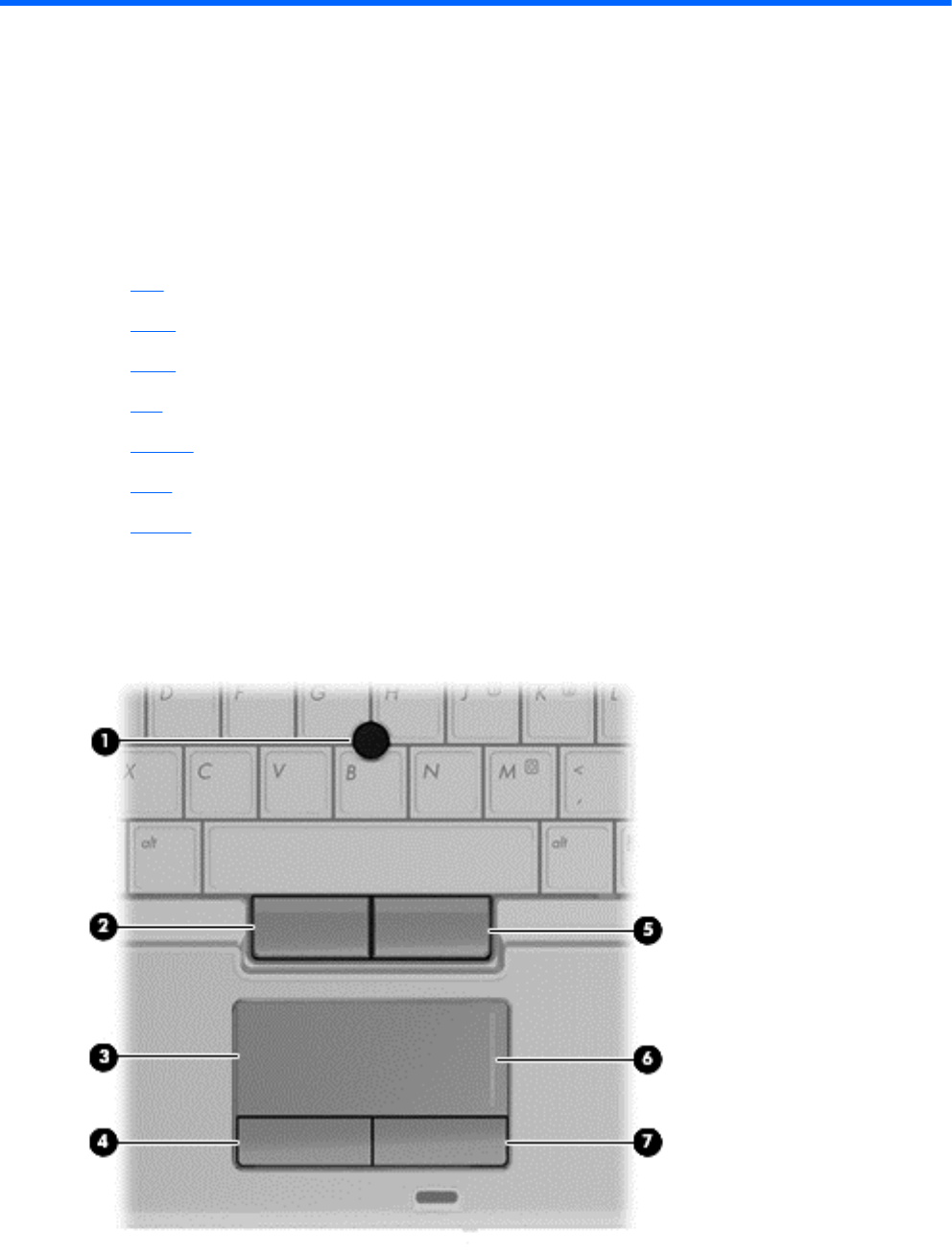Broadcom BRCM1050 802.11g/Draft 802.11n WLAN PCI-E Minicard User Manual Host 1 of 2
Broadcom Corporation 802.11g/Draft 802.11n WLAN PCI-E Minicard Host 1 of 2
Broadcom >
Contents
Host user manual 1 of 2

Getting Started
HP Notebook

© Copyright 2011 Hewlett-Packard
Development Company, L.P.
Bluetooth is a trademark owned by its
proprietor and used by Hewlett-Packard
Company under license. Microsoft and
Windows are U.S. registered trademarks of
Microsoft Corporation. SD Logo is a
trademark of its proprietor.
The information contained herein is subject
to change without notice. The only
warranties for HP products and services are
set forth in the express warranty statements
accompanying such products and services.
Nothing herein should be construed as
constituting an additional warranty. HP shall
not be liable for technical or editorial errors
or omissions contained herein.
First Edition: January 2011
Document Part Number: 641801-001
Product notice
This guide describes features that are
common to most models. Some features
may not be available on your computer.
Software terms
By installing, copying, downloading, or
otherwise using any software product
preinstalled on this computer, you agree to
be bound by the terms of the HP End User
License Agreement (EULA). If you do not
accept these license terms, your sole
remedy is to return the entire unused
product (hardware and software) within 14
days for a refund subject to the refund
policy of your place of purchase.
For any further information or for requesting
a full refund of the computer, please
contact your local point of sale (the seller).

Safety warning notice
WARNING! To reduce the possibility of heat-related injuries or of overheating the computer, do not
place the computer directly on your lap or obstruct the computer air vents. Use the computer only on
a hard, flat surface. Do not allow another hard surface, such as an adjoining optional printer, or a soft
surface, such as pillows or rugs or clothing, to block airflow. Also, do not allow the AC adapter to
come into contact with the skin or a soft surface, such as pillows or rugs or clothing, during operation.
The computer and the AC adapter comply with the user-accessible surface temperature limits defined
by the International Standard for Safety of Information Technology Equipment (IEC 60950).
iii
iv Safety warning notice

Table of contents
1 Welcome .......................................................................................................................................................... 1
What's new? ......................................................................................................................................... 2
Finding information ............................................................................................................................... 3
2 Getting to know your computer ..................................................................................................................... 5
Top ....................................................................................................................................................... 5
TouchPad ............................................................................................................................ 5
Lights ................................................................................................................................... 6
Buttons ................................................................................................................................. 8
Keys ..................................................................................................................................... 9
Front ................................................................................................................................................... 10
Right ................................................................................................................................................... 11
Left ..................................................................................................................................................... 12
Display ................................................................................................................................................ 13
Rear .................................................................................................................................................... 14
Bottom ................................................................................................................................................ 15
3 HP QuickWeb ................................................................................................................................................ 16
Starting HP QuickWeb ....................................................................................................................... 17
4 Networking .................................................................................................................................................... 18
Using an Internet service provider (ISP) ............................................................................................ 19
Connecting to a wireless network ....................................................................................................... 19
Connecting to an existing WLAN ....................................................................................... 19
Setting up a new WLAN network ....................................................................................... 20
Configuring a wireless router ............................................................................ 21
Protecting your WLAN ....................................................................................... 21
5 Keyboard and pointing devices ................................................................................................................... 22
Using the keyboard ............................................................................................................................ 23
Identifying the hotkeys ....................................................................................................... 23
............................................................................................................................................ 24
Using keypads ................................................................................................................... 24
v
Using the embedded numeric keypad ............................................................... 24
Turning the embedded numeric keypad on and off .......................... 26
Switching key functions on the embedded numeric keypad ............. 26
Using an optional external numeric keypad ...................................................... 26
Rotating the display ............................................................................................................................ 27
Using pointing devices ....................................................................................................................... 28
Setting pointing device preferences ................................................................................... 28
Using the pointing stick ...................................................................................................... 28
Using the TouchPad .......................................................................................................... 28
Turning the TouchPad off and on ...................................................................... 30
Navigating ......................................................................................................... 30
Selecting ........................................................................................................... 31
Using TouchPad gestures ................................................................................. 31
Scrolling ............................................................................................ 32
Pinching/Zooming ............................................................................. 32
Rotating ............................................................................................ 33
Using the digitizer pen ....................................................................................................... 33
Identifying the pen components ........................................................................ 33
Holding the pen ................................................................................................. 33
Storing the pen .................................................................................................. 34
Using touch screen gestures .............................................................................................................. 34
Tapping (or clicking) .......................................................................................................... 34
Flicking ............................................................................................................................... 35
Dragging ............................................................................................................................ 35
Scrolling ............................................................................................................................. 36
Rotating ............................................................................................................................. 36
Pinching/Zooming .............................................................................................................. 37
Setting touch screen preferences ...................................................................................... 37
6 Maintenance .................................................................................................................................................. 38
Inserting or removing the battery ........................................................................................................ 38
Replacing or upgrading the hard drive ............................................................................................... 40
Removing the hard drive .................................................................................................... 40
Installing a hard drive ......................................................................................................... 41
Adding or replacing memory modules ................................................................................................ 42
Updating programs and drivers .......................................................................................................... 46
7 Backup and recovery .................................................................................................................................... 47
Windows 7 .......................................................................................................................................... 47
Backing up your information .............................................................................................. 47
Performing a system recovery ........................................................................................... 48
Using the Windows recovery tools .................................................................... 49
Using f11 recovery tools .................................................................................... 49
vi
Using a Windows 7 operating system DVD (purchased separately) ................. 50
Windows Vista .................................................................................................................................... 51
Backing up your information .............................................................................................. 51
Performing a recovery ....................................................................................................... 52
Using the Windows recovery tools .................................................................... 52
Using f11 recovery tools .................................................................................... 53
Using a Windows Vista operating system DVD (purchased separately) ........... 53
8 Customer support ......................................................................................................................................... 55
Contacting customer support ............................................................................................................. 56
Labels ................................................................................................................................................. 57
9 Specifications ................................................................................................................................................ 58
Input power ......................................................................................................................................... 59
Operating environment ....................................................................................................................... 60
Index ................................................................................................................................................................... 61
vii
viii

1Welcome
●What's new?
●Finding information
After you set up and register the computer, it is important to take the following steps:
●Connect to the Internet—Set up your wired or wireless network so that you can connect to the
Internet. For more information, refer to Networking on page 18.
●Update your antivirus software—Protect your computer from damage caused by viruses. The
software is preinstalled on the computer and includes a limited subscription for free updates. For
more information, refer to the HP Notebook Reference Guide. For instructions on accessing this
guide, refer to Finding information on page 3.
●Get to know your computer—Learn about your computer features. Refer to Getting to know
your computer on page 5 and Keyboard and pointing devices on page 22 for additional
information.
●Find installed software—Access a list of the software preinstalled on the computer. Select
Start > All Programs. For details about using the software included with the computer, refer to
the software manufacturer's instructions, which may be provided with the software or on the
manufacturer's Web site.
1
What's new?
2 Chapter 1 Welcome

Finding information
The computer comes with several resources to help you perform various tasks.
Resources For information about
Quick Setup poster ●How to set up the computer
●Help to identify computer components
Getting Started
To access this guide:
Select Start > Help and Support > User Guides.
– or –
Select Start > All Programs > HP > HP
Documentation.
●Computer features
●How to connect to a wireless network specifications
●How to use the keyboard and pointing devices
●How to replace or upgrade the hard drive and memory
modules
●How to perform a backup and recovery
●How to contact customer support
●Computer specifications
HP Notebook Reference Guide
To access this guide:
Select Start > Help and Support > User Guides.
– or –
Select Start > All Programs > HP > HP
Documentation.
●Power management features
●How to maximize battery life
●How to use the multimedia features of the computer
●How to protect the computer
●How to care for the computer
●How to update the software
Help and Support
To access Help and Support, select Start > Help and
Support.
NOTE: For country- or region-specific support, go to
http://www.hp.com/support, select your country or
region, and follow the on-screen instructions.
●Operating system information
●Software, driver, and BIOS updates
●Troubleshooting tools
●How to access technical support
Regulatory, Safety, and Environmental Notices
To access this guide:
Select Start > Help and Support > User Guides.
– or –
Select Start > All Programs > HP > HP
Documentation.
●Regulatory and safety information
●Battery disposal information
Finding information 3

Resources For information about
Safety & Comfort Guide
To access this guide:
Select Start > Help and Support > User Guides.
– or –
Select Start >All Programs > HP > HP
Documentation.
– or –
Go to http://www.hp.com/ergo.
●Proper workstation setup, posture, health, and work habits
●Electrical and mechanical safety information
Worldwide Telephone Numbers booklet
This booklet is provided with your computer.
HP support telephone numbers
HP Web site
To access this Web site, go to http://www.hp.com/
support.
●Support information
●Ordering parts and finding additional help
●Accessories available for the device
Limited Warranty*
To access the warranty:
Select Start > Help and Support > User Guides >
View Warranty Information.
– or –
Select Start > All Programs > HP > HP
Documentation > View Warranty Information.
– or –
Go to http://www.hp.com/go/orderdocuments.
Warranty information
*You may find the expressly provided HP Limited Warranty applicable to your product located with the electronic guides on
your computer and/or on the CD/DVD provided in the box. Some countries/regions may provide a printed HP Limited
Warranty in the box. In countries/regions where the warranty is not provided in printed format, you may request a printed
copy at http://www.hp.com/go/orderdocuments or write to:
●North America: Hewlett-Packard, MS POD, 11311 Chinden Blvd, Boise, ID 83714, USA
●Europe, Middle East, Africa: Hewlett-Packard, POD, Via G. Di Vittorio, 9, 20063, Cernusco s/Naviglio (MI), Italy
●Asia Pacific: Hewlett-Packard, POD, P.O. Box 200, Alexandra Post Office, Singapore 911507
Please include your product number, warranty period (found on your serial number label), name, and postal address.
4 Chapter 1 Welcome
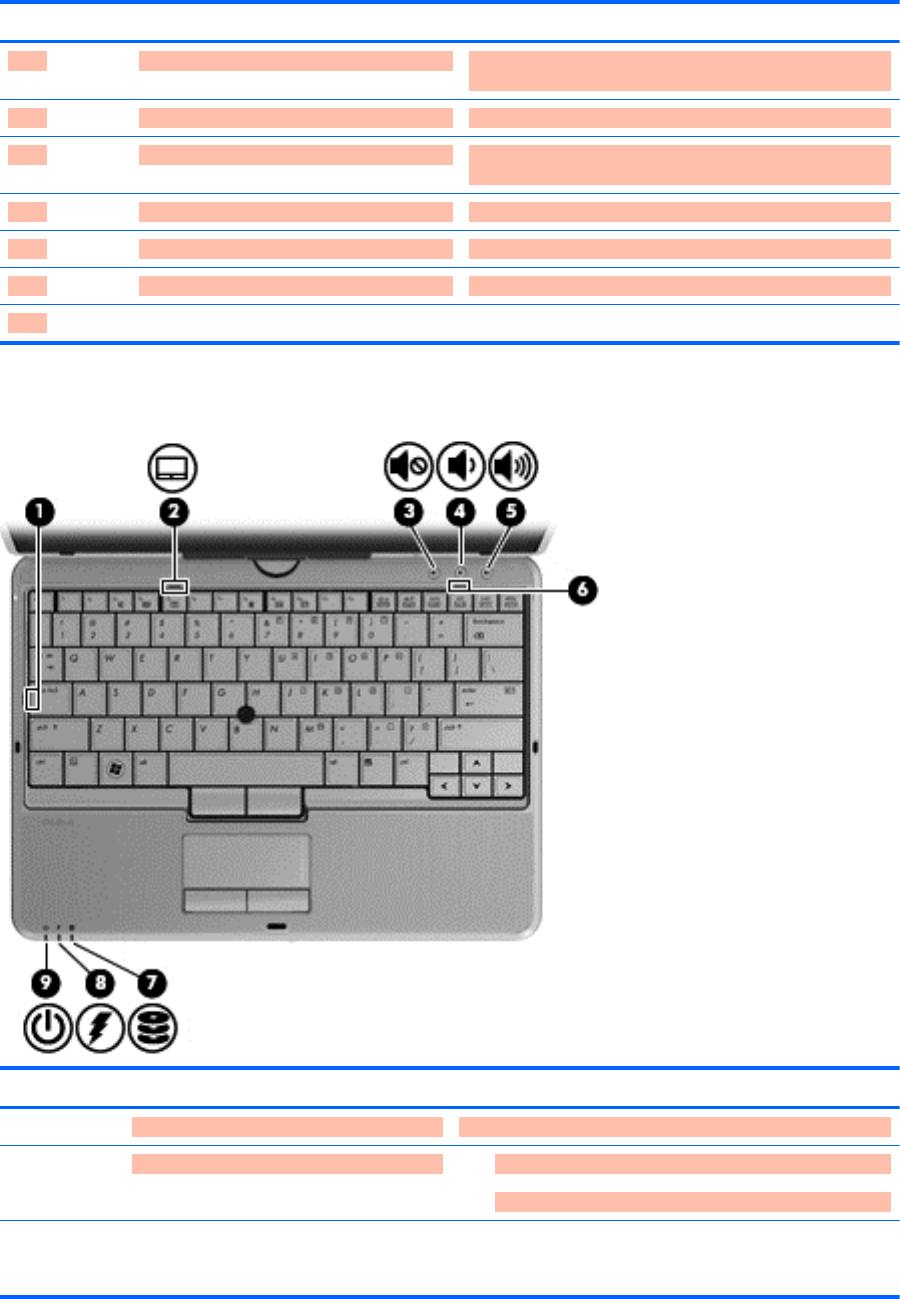
Component Description
(1) Pointing stick Moves the pointer and selects or activates items on the
screen.
(2) Left pointing stick button Functions like the left button on an external mouse.
(3) TouchPad Moves the pointer and selects or activates items on the
screen.
(4) Left TouchPad button Functions like the left button on an external mouse.
(5) Right pointing stick button Functions like the right button on an external mouse.
(6) TouchPad zone Scrolls up or down.
(7) Right TouchPad button Functions like the right button on an external mouse.
Lights
Component Description
(1) Caps lock light On: Caps lock is on.
(2) TouchPad light ●Off: TouchPad is on.
●Amber: TouchPad is off.
(3) Mute light ●Amber: Computer sound is off.
●Off: Computer sound is on.
6 Chapter 2 Getting to know your computer

Component Description
(4) Volume down light Blinking: The volume scroll zone is being used to decrease
speaker volume.
(5) Volume up light Blinking: The volume scroll zone is being used to increase
speaker volume
(6) Num lock light On: Num lock is on or the embedded numeric keypad is
enabled.
(7) Drive light ●Blinking turquoise: The hard drive or optical drive is
being accessed.
●Amber: HP 3D DriveGuard has temporarily parked the
hard drive.
(8) Battery light ●Amber: A battery is charging.
●Turquoise: A battery is close to full charge capacity.
●Blinking amber: A battery that is the only available
power source has reached a low battery level. When
the battery reaches a critical battery level, the battery
light begins blinking rapidly.
●Off: If the computer is plugged into an external power
source, the light turns off when all batteries in the
computer are fully charged. If the computer is not
plugged into an external power source, the light stays
off until the battery reaches a low battery level.
(9) Power light ●On: The computer is on.
●Blinking: The computer is in the Sleep state.
●Off: The computer is off or in Hibernation.
Top 7
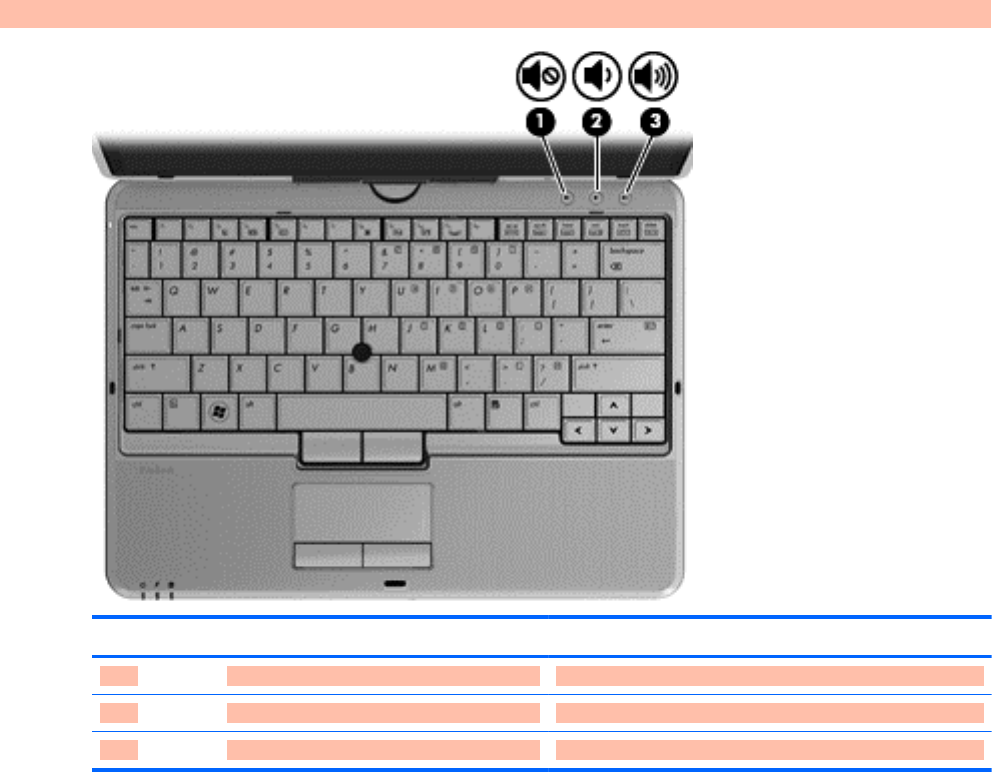
Buttons
Component Description
(1) Volume mute button Mutes and restores speaker sound.
(2) Volume down button Decreases computer volume.
(3) Volume up button Increases computer volume.
8 Chapter 2 Getting to know your computer
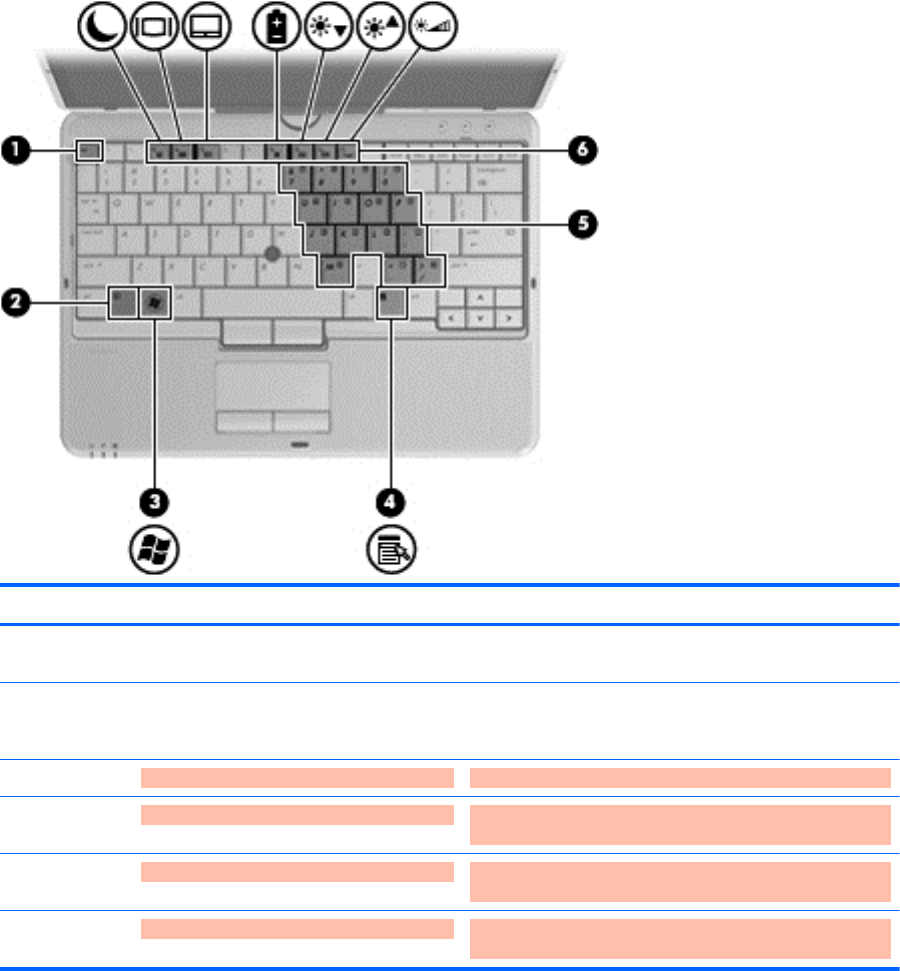
Keys
Component Description
(1) esc key Displays system information when pressed in combination
with the fn key.
(2) fn key Executes frequently used system functions when pressed
in combination with a function key, the num lk key, or the
esc key.
(3) Start key Displays the Start menu.
(4) Menu key Displays the active program’s shortcut menu (same as
right-click menu).
(5) Embedded numeric keypad keys Can be used like the keys on an external numeric keypad
when pressed in combination with the fn and num lk keys.
(6) Function keys Execute frequently used system functions when pressed in
combination with the fn key.
Top 9
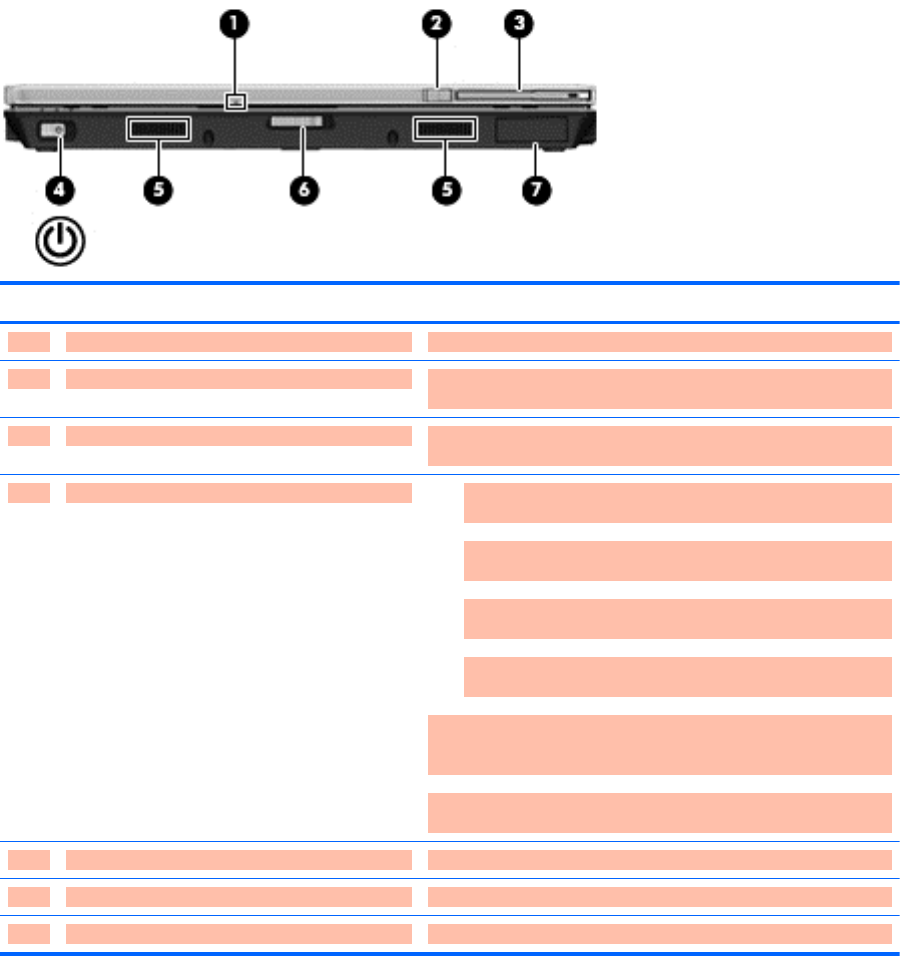
Front
Component Description
(1) Webcam light On: The webcam is in use.
(2) External WWAN antenna button Opens the external wireless wide area network (WWAN)
antenna.
(3) External WWAN antenna Sends and receives wireless signals to communicate with
WWANs.
(4) Power switch ●When the computer is off, slide the switch to the right to turn
on the computer.
●When the computer is on, slide the switch to the right to
shut down the computer.
●When the computer is in the Sleep state, slide the switch to
the right briefly to exit Sleep.
●When the computer is in Hibernation, slide the switch to the
right briefly to exit Hibernation.
If the computer has stopped responding and Windows shutdown
procedures are ineffective, slide the switch to the right and hold
for at least 5 seconds to turn off the computer.
To learn more about your power settings, select Start > Control
Panel > System and Security > Power Options.
(5) Speakers (2) Produce sound.
(6) Display release latch Opens the computer.
(7) Bluetooth® compartment Contains an optional Bluetooth device.
10 Chapter 2 Getting to know your computer

Right
Component Description
(1) HP Fingerprint Sensor (fingerprint reader) Allows a fingerprint logon to Windows instead of a
password logon.
(2) QuickWeb button ●When the computer is off or in Hibernation, press the
button to open HP QuickWeb.
●When the computer is in Microsoft Windows, press
the button to open the default Web browser.
●When the computer is in HP QuickWeb, press the
button to open the default Web browser.
NOTE: For more information, refer to “HP QuickWeb” in
this guide and to the HP QuickWeb software Help. If your
computer does not have HP QuickWeb software, the
button does not perform any action or function.
(3) Audio-out (headphone) jack/Audio-in
(microphone) jack
Connects optional powered stereo speakers, headphones,
earbuds, a headset, or television audio. Also connects an
optional headset microphone.
WARNING! To reduce the risk of personal injury, adjust
the volume before putting on headphones, earbuds, or a
headset. For additional safety information, refer to the
Regulatory, Safety, and Environmental Notices.
NOTE: When a device is connected to the jack, the
computer speakers are disabled.
NOTE: A 4–conductor audio jack plug headphone with
microphone is needed in order to use the microphone
function.
(4) Smart card reader Supports optional smart cards and Java™ Cards.
(5) USB ports (2) Connect optional USB devices.
(6) RJ-11 (modem) jack (select models only) Connects a modem cable.
(7) Security cable slot Attaches an optional security cable to the computer.
NOTE: The security cable is designed to act as a
deterrent, but it may not prevent the computer from being
mishandled or stolen.
Right 11
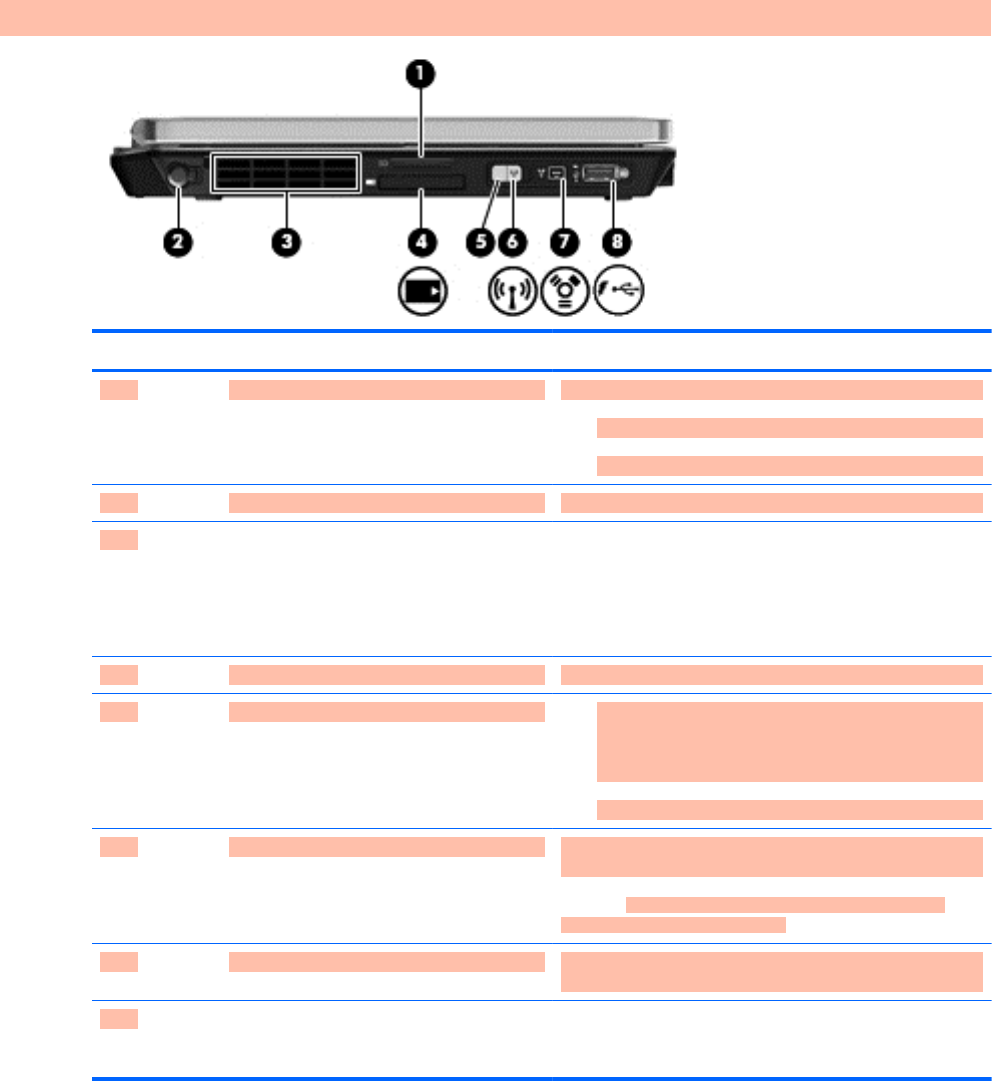
Left
Component Description
(1) Media Card Reader Supports the following digital card formats:
●MultiMediaCard
●Secure Digital (SD) Card
(2) Pen holder Stores the digitizer pen.
(3) Vent Enables airflow to cool internal components.
NOTE: The computer fan starts up automatically to cool
internal components and prevent overheating. It is normal
for the internal fan to cycle on and off during routine
operation.
(4) Express card slot (select models only) Supports optional ExpressCards.
(5) Wireless light ●Blue: An integrated wireless device, such as a
wireless local area network (WLAN) device, the HP
Mobile Broadband Module, and/or a Bluetooth device,
is on.
●Amber: All wireless devices are off.
(6) Wireless switch Turns the wireless feature on or off, but does not create a
wireless connection.
NOTE: A wireless network must be set up in order to
establish a wireless connection.
(7) 1394 port Connects an optional IEEE 1394 or 1394a device, such as
a camcorder.
(8) eSATA/USB port Connects a high-performance eSATA component, such as
an eSATA external hard drive, or connects an optional USB
device.
12 Chapter 2 Getting to know your computer
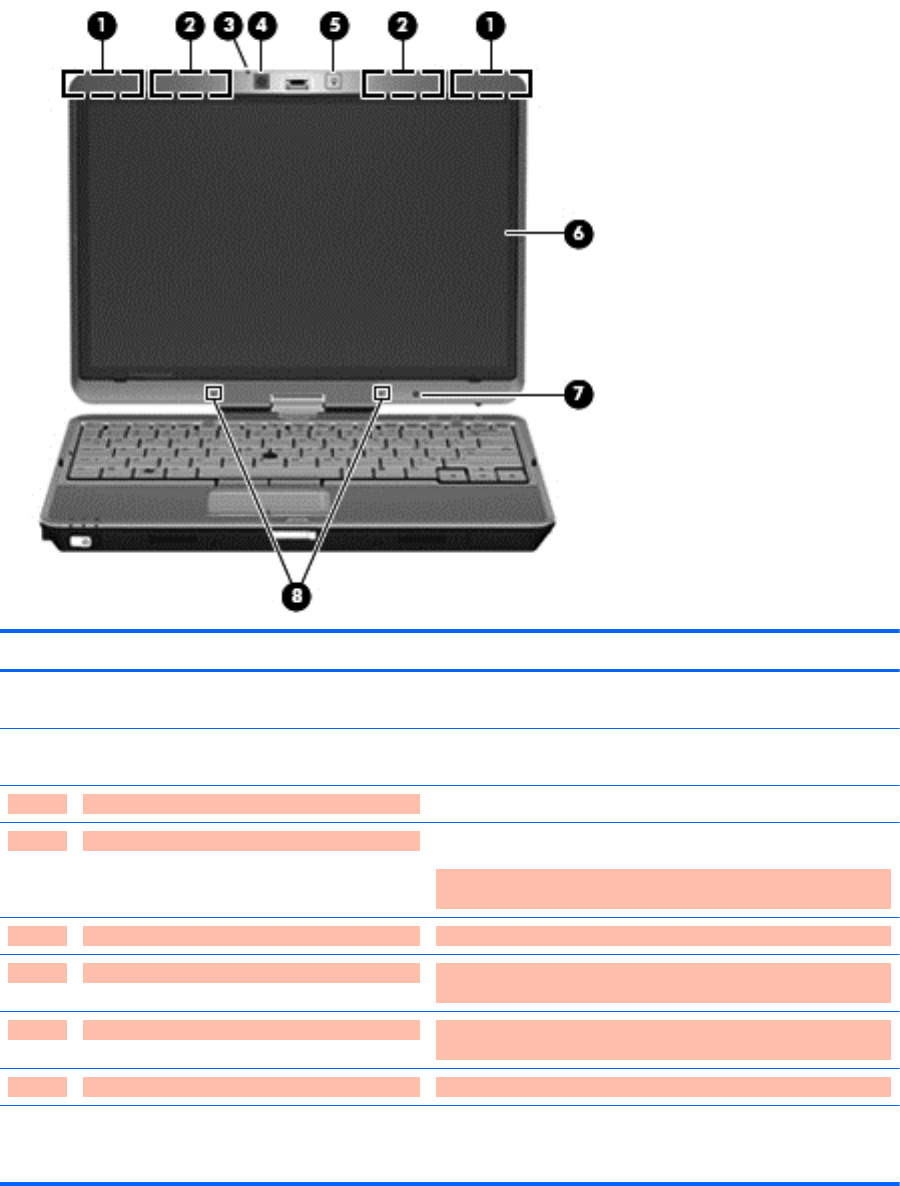
Display
Component Description
(1) WWAN antennas (2)* (select models only) Send and receive wireless signals to communicate with wireless
wide-area networks (WWAN).
(2) WLAN antennas (2)* Send and receive wireless signals to communicate with wireless
local area networks (WLAN).
(3) Webcam light On: The webcam is in use.
(4) Webcam Records video and captures still photographs.
To use the webcam, select Start > All Programs > HP >
HP Webcam.
(5) Keyboard light button Opens and turns on the keyboard light.
(6) Touch screen Allows you to perform certain actions on the touch screen using
your fingers.
(7) Ambient light sensor Automatically adjusts the display brightness based on the
lighting conditions in your environment.
(8) Internal microphones (2) Record sound.
*The antennas are not visible from the outside of the computer. For optimal transmission, keep the areas immediately
around the antennas free from obstructions. To see wireless regulatory notices, refer to the section of the Regulatory, Safety,
and Environmental Notices that applies to your country or region. These notices are located in Help and Support.
Display 13
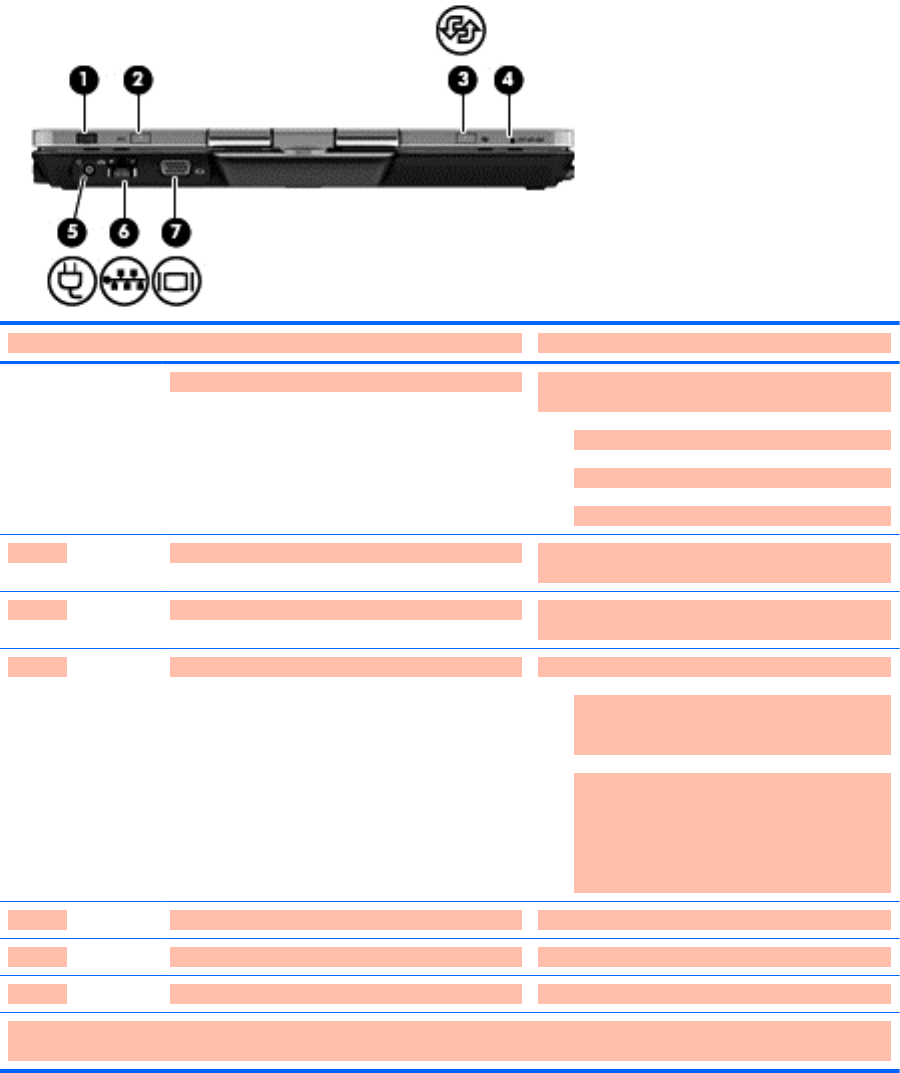
Rear
Component Description
(1) Jog dial In tablet mode, functions like the enter key and
the up and down arrows on a standard keyboard.
●Press inward to enter a command.
●Rotate up to scroll up.
●Rotate down to scroll down.
(2) esc button In tablet mode, allows you to exit or escape out of
an application.
(3) Rotate button In tablet mode, switches the image between
landscape and portrait orientation.
(4) ctrl+alt+del button* In tablet mode:
●While Windows is running, press the button
with the pen to enter the ctrl+alt+del
command.*
●While the Computer Setup utility is running,
press the button with the pen to enter the
reset command. The computer resets and all
unsaved information is lost. The reset
function can be used to restore functionality
when the system has become unresponsive.
(5) Power connector Connects an AC adapter.
(6) RJ-45 (network) jack Connects a network cable.
(7) External monitor port Connects an external VGA monitor or projector.
*To protect your work and the system, the ctrl+alt+delete command cannot be entered using the ctrl, alt, and del keys on the
on-screen keyboard.
14 Chapter 2 Getting to know your computer
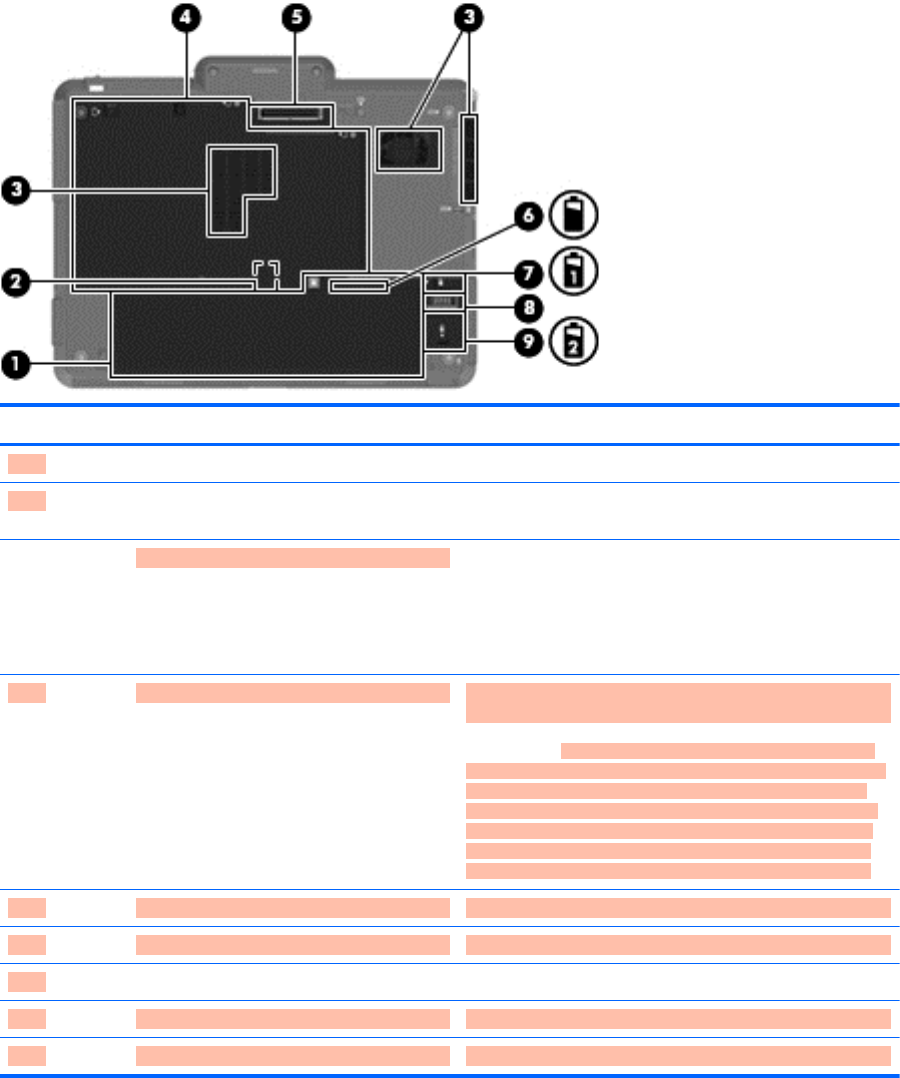
Bottom
Component Description
(1) Battery bay Holds the battery.
(2) SIM slot Contains a wireless subscriber identity module (SIM). The
SIM slot is located inside the battery bay.
(3) Vents (3) Enable airflow to cool internal components.
NOTE: The computer fan starts up automatically to cool
internal components and prevent overheating. It is normal
for the internal fan to cycle on and off during routine
operation.
(4) Hard drive bay Contains the hard drive, the wireless LAN module slot, the
WWAN module slot, and the memory module slot.
CAUTION: To prevent an unresponsive system, replace
the wireless module only with a wireless module authorized
for use in the computer by the governmental agency that
regulates wireless devices in your country or region. If you
replace the module and then receive a warning message,
remove the module to restore computer functionality, and
then contact technical support through Help and Support.
(5) Docking connector Connects an optional docking device.
(6) Charge level indicator Displays the approximate remaining battery charge.
(7) Battery release latch Releases the battery from the battery bay.
(8) Accessory battery connector Connects an optional accessory battery.
(9) Accessory battery connector door Slides open to expose the accessory battery connector.
Bottom 15

3 HP QuickWeb
●Starting HP QuickWeb
The HP QuickWeb environment provides a fun and engaging way to perform many of your favorite
activities. Your computer is ready to go within seconds of starting QuickWeb, allowing you to rapidly
access the Internet, widgets, and communication programs. Simply press the QuickWeb button on
your computer, and then start browsing the Internet, communicating with Skype, and exploring other
HP QuickWeb programs.
Your HP QuickWeb Home screen includes the following features:
●Web browser—Search and browse the Internet, and create links to your favorite Web sites.
●Skype—Communicate using Skype, an application that uses voice over Internet protocol (VoIP).
Skype lets you make conference calls or have video chats with one or more people at a time.
You can also make long-distance phone calls to land lines.
●QuickWeb E-Mail—Read and send e-mail by connecting to Web-based e-mail providers, such
as Gmail, or to your own mail server.
●Widgets—Start using widgets for news, weather, social networking, stocks, a calculator, sticky
notes, and more. You can also use Widget Manager to add more widgets to the HP QuickWeb
Home screen.
NOTE: For additional information about using HP QuickWeb, refer to the HP QuickWeb software
Help.
16 Chapter 3 HP QuickWeb

Starting HP QuickWeb
▲To start HP QuickWeb, press the QuickWeb button when the computer is off or in Hibernation.
The following table explains the different behaviors of the QuickWeb button.
Button Behavior
QuickWeb button ●When the computer is off or in Hibernation, opens HP QuickWeb.
●When the computer is in Microsoft Windows, opens the default Web browser.
●When the computer is in HP QuickWeb, opens the default Web browser.
NOTE: If your computer does not have HP QuickWeb software, the button does not
perform any action or function.
NOTE: For more information, refer to the HP QuickWeb software Help.
Starting HP QuickWeb 17

4Networking
●Using an Internet service provider (ISP)
●Connecting to a wireless network
NOTE: Internet hardware and software features vary depending on computer model and your
location.
Your computer may support one or both of the following types of Internet access:
●Wireless—For mobile Internet access, you can use a wireless connection. Refer to Connecting
to an existing WLAN on page 19 or Setting up a new WLAN network on page 20.
●Wired—You can access the Internet by connecting to a wired network. For information on
connecting to a wired network, refer to the HP Notebook Reference Guide.
18 Chapter 4 Networking

Using an Internet service provider (ISP)
Before you can connect to the Internet, you must establish an ISP account. Contact a local ISP to
purchase Internet service and a modem. The ISP will help set up the modem, install a network cable
to connect your wireless computer to the modem, and test the Internet service.
NOTE: Your ISP will give you a user ID and password to access the Internet. Record this
information and store it in a safe place.
The following features will help you set up a new Internet account or configure the computer to use an
existing account:
●Internet Services & Offers (available in some locations)—This utility assists with signing up
for a new Internet account and configuring the computer to use an existing account. To access
this utility, select Start > All Programs > Online Services > Get Online.
●ISP-provided icons (available in some locations)—These icons may be displayed either
individually on the Windows desktop or grouped in a desktop folder named Online Services. To
set up a new Internet account or configure the computer to use an existing account, double-click
an icon, and then follow the on-screen instructions.
●Windows Connect to the Internet Wizard—You can use the Windows Connect to the Internet
Wizard to connect to the Internet in any of these situations:
◦You already have an account with an ISP.
◦You do not have an Internet account and want to select an ISP from the list provided within
the wizard. (The list of ISP providers is not available in all regions.)
◦You have selected an unlisted ISP, and the ISP has provided you with information such as
a specific IP address and POP3 and SMTP settings.
To access the Windows Connect to the Internet Wizard and instructions for using it, select
Start > Control Panel > Network and Internet > Network and Sharing Center.
NOTE: If you are prompted within the wizard to choose between enabling or disabling
Windows Firewall, choose to enable the firewall.
Connecting to a wireless network
Wireless technology transfers data across radio waves instead of wires. Your computer may be
equipped with one or more of the following wireless devices:
●Wireless local area network (WLAN) device
●HP Mobile Broadband Module, a wireless wide area network (WWAN) device
●Bluetooth device
For more information on wireless technology and connecting to a wireless network, refer to the
HP Notebook Reference Guide and information and Web site links provided in Help and Support.
Connecting to an existing WLAN
1. Turn on the computer.
2. Be sure that the WLAN device is on.
Using an Internet service provider (ISP) 19
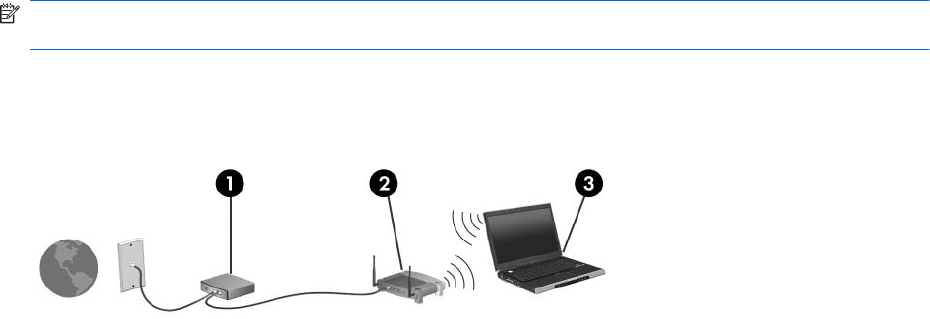
3. Click the network icon in the notification area, at the far right of the taskbar.
4. Select a network to connect to.
5. Click Connect.
6. If required, enter the security key.
Setting up a new WLAN network
Required equipment:
●A broadband modem (either DSL or cable) (1) and high-speed Internet service purchased from
an Internet service provider (ISP)
●A wireless router (purchased separately) (2)
●Your new wireless computer (3)
NOTE: Some modems have a built-in wireless router. Check with your ISP to determine what type
of modem you have.
The illustration shows an example of a completed WLAN network installation that is connected to the
Internet. As your network grows, additional wireless and wired computers can be connected to the
network to access the Internet.
20 Chapter 4 Networking

Configuring a wireless router
For help in setting up a WLAN, refer to the information provided by your router manufacturer or your
ISP.
The Windows operating system also provides tools to help you set up a new wireless network. To use
the Windows tools to set up your network:
●Windows 7—Select Start > Control Panel > Network and Internet > Network and Sharing
Center > Set up a new connection or network > Set up a network. Then follow the on-screen
instructions.
●Windows Vista—Select Start > Control Panel > Network and Internet > Network and
Sharing Center > Set up a connection or network > Set up a wireless router or access
point. Then follow the on-screen instructions.
NOTE: It is recommended that you initially connect your new wireless computer to the router by
using the network cable provided with the router. When the computer successfully connects to the
Internet, you can disconnect the cable, and then access the Internet through your wireless network.
Protecting your WLAN
When you set up a WLAN or access an existing WLAN, always turn on security features to protect
your network from unauthorized access.
For information on protecting your WLAN, refer to the HP Notebook Reference Guide.
Connecting to a wireless network 21
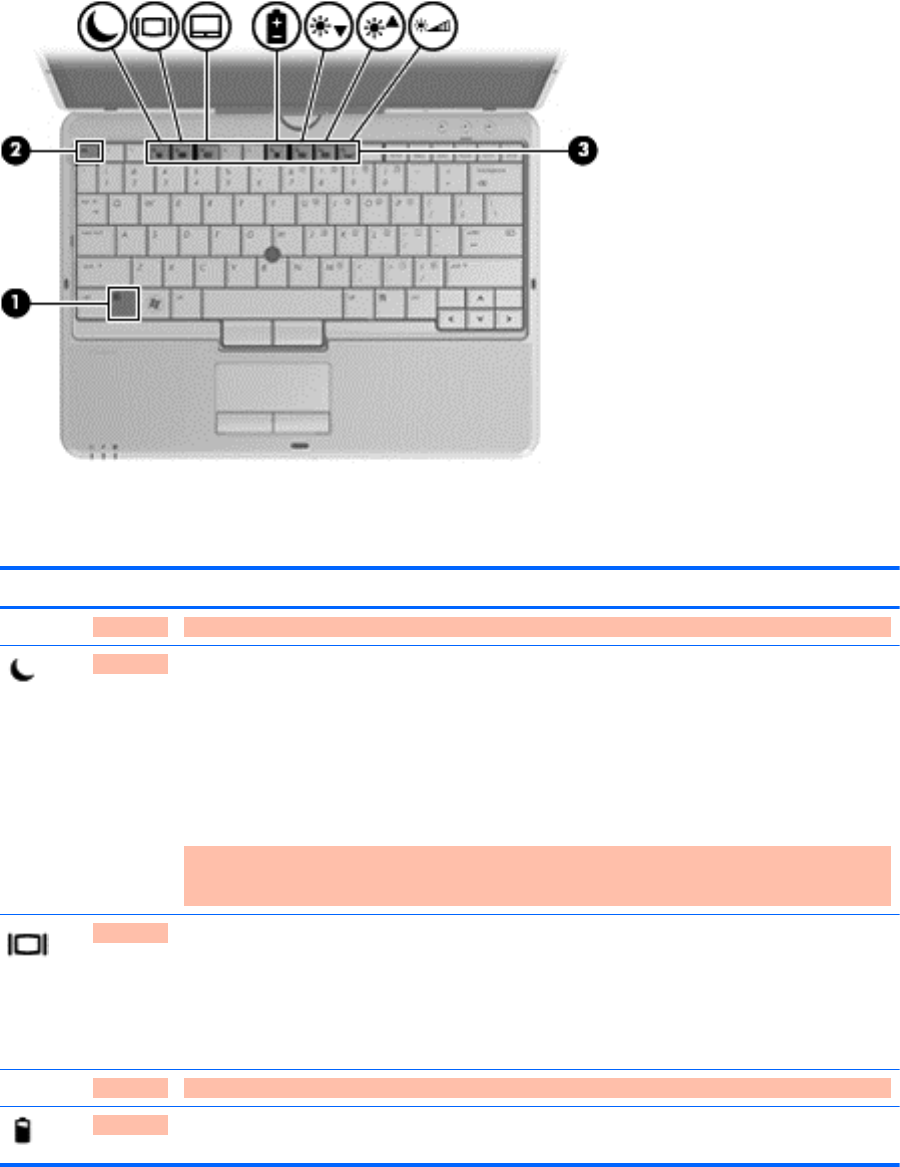
Using the keyboard
Identifying the hotkeys
A hotkey is a combination of the fn key (1) and either the esc key (2) or one of the function keys (3).
To use a hotkey:
▲Briefly press the fn key, and then briefly press the second key of the hotkey combination.
Hotkey combination Description
fn+esc Displays system information.
fn+f3 Initiates Sleep, which saves your information in system. The display and other system components
turn off and power is conserved.
To exit Sleep, briefly press the power button.
CAUTION: To reduce the risk of information loss, save your work before initiating Sleep.
NOTE: If a critical battery level occurs while the computer is in the Sleep state, the computer
initiates Hibernation and the information stored in is saved to the hard drive.
The function of the fn+f3 hotkey can be changed. For example, you can set the fn+f3 hotkey to
initiate Hibernation instead of Sleep. In all Windows operating system windows, references to the
sleep button apply to the fn+f3 hotkey.
fn+f4 Switches the screen image among display devices connected to the system. For example, if a
monitor is connected to the computer, fn+f4 alternates the screen image from computer display to
monitor display to simultaneous display on both the computer and the monitor.
Most external monitors receive video information from the computer using the external VGA video
standard. The fn+f4 hotkey can also alternate images among other devices that are receiving video
information from the computer.
fn+f5 Enable/disable the TouchPad.
fn+f8 Displays charge information for all installed batteries. The display indicates which batteries are
charging and reports the amount of charge remaining in each battery.
Using the keyboard 23
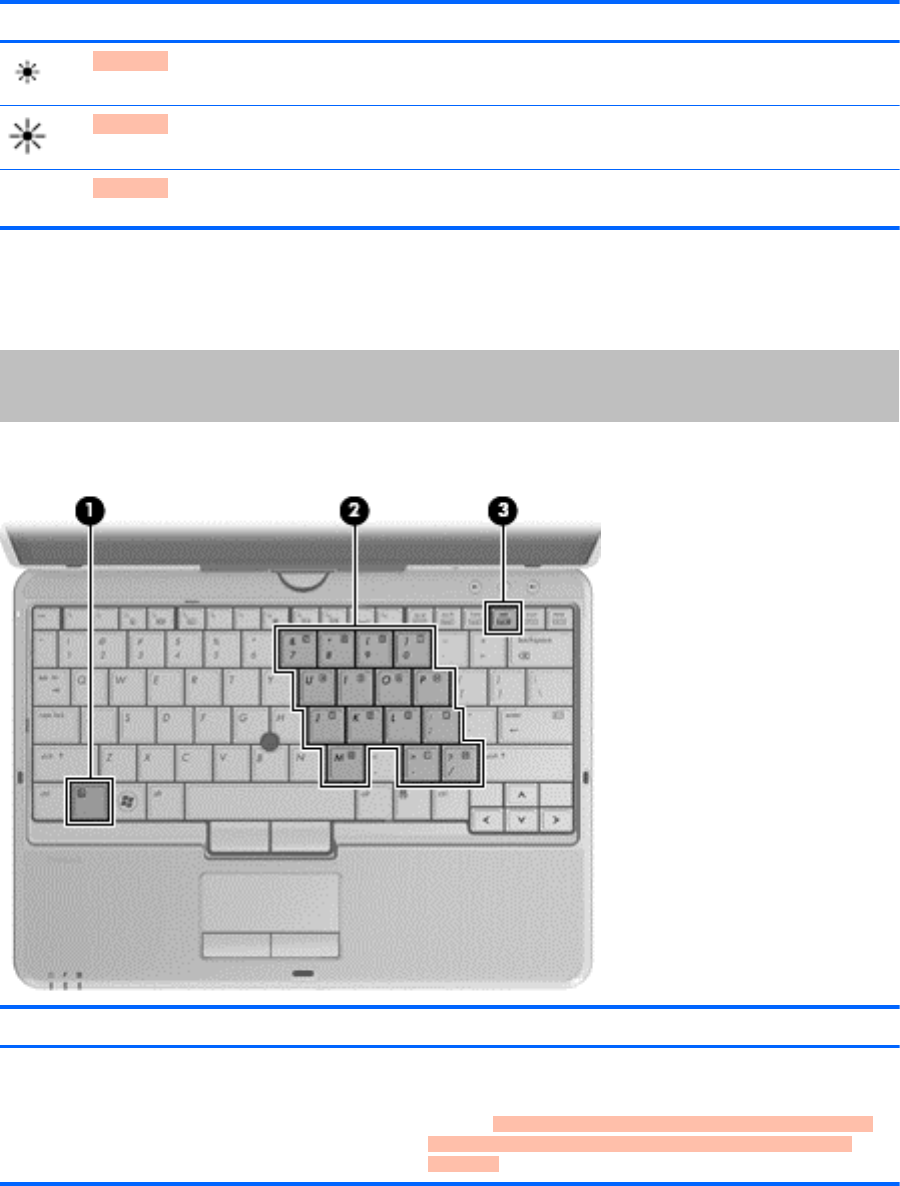
Hotkey combination Description
fn+f9 Decreases the screen brightness level.
fn+f10 Increases the screen brightness level.
fn+f11 Activates and deactivates the ambient light. When activated, the ambient light sensor automatically
adjusts the display brightness based on the lighting conditions in your environment.
Using keypads
The computer includes either an embedded numeric keypad or an integrated numeric keypad. The
computer also supports an optional external numeric keypad or an optional external keyboard that
includes a numeric keypad.
Using the embedded numeric keypad
Component Description
(1) fn key Turns the embedded numeric keypad on and off when pressed in
combination with the num lk key.
NOTE: The embedded numeric keypad will not function while
an external keyboard or numeric keypad is connected to the
computer.
24 Chapter 5 Keyboard and pointing devices

Component Description
(2) Embedded numeric keypad When the keypad is turned on, it can be used like an external
numeric keypad.
Each key on the keypad performs the function indicated by the
icon in the upper-right corner of the key.
(3) num lk key Turns the embedded numeric keypad on and off when pressed in
combination with the fn key.
NOTE: The keypad function that is active when the computer is
turned off is reinstated when the computer is turned back on.
Using the keyboard 25

Turning the embedded numeric keypad on and off
Press fn+num lk to turn on the embedded numeric keypad. Press fn+num lk again to turn off the
keypad.
NOTE: The embedded numeric keypad is turned off while an external keyboard or numeric keypad
is connected to the computer.
Switching key functions on the embedded numeric keypad
You can temporarily alternate the functions of keys on the embedded numeric keypad between their
standard keyboard functions and their keypad functions:
●To use the numeric function of a keypad key while the keypad is off, press and hold the fn key
while pressing the keypad key.
●To use the standard function of a keypad key while the keypad is on:
◦Press and hold the fn key to type in lowercase.
◦Press and hold fn+shift to type in uppercase.
Using an optional external numeric keypad
Keys on most external numeric keypads function differently according to whether num lock is on or
off. (Num lock is turned off at the factory.) For example:
●When num lock is on, most keypad keys type numbers.
●When num lock is off, most keypad keys function like the arrow, page up, or page down keys.
When num lock on an external keypad is turned on, the num lock light on the computer is turned on.
When num lock on an external keypad is turned off, the num lock light on the computer is turned off.
To turn num lock on or off on an external keypad as you work:
▲Press the num lk key on the external keypad, not on the computer.
26 Chapter 5 Keyboard and pointing devices
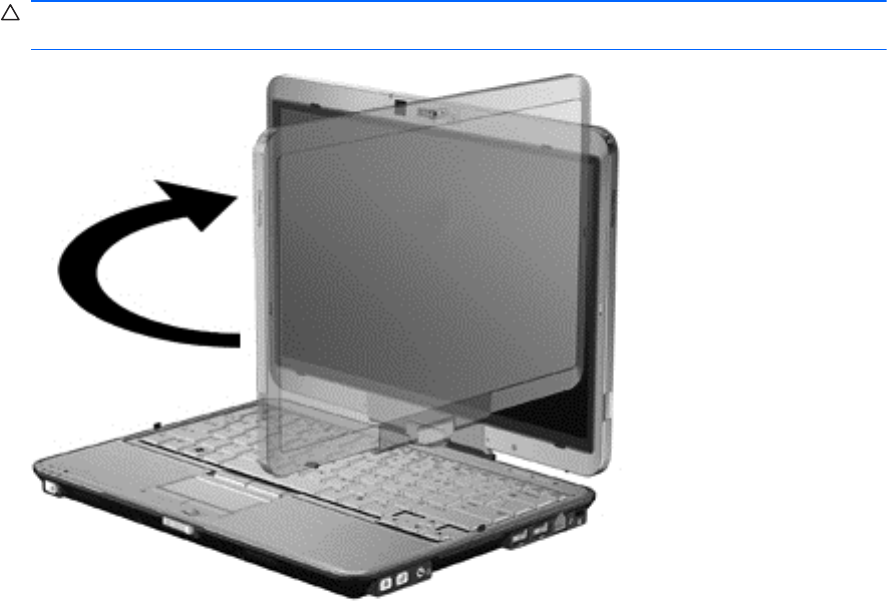
Rotating the display
To use the computer in slate mode:
1. Open the display.
2. Rotate the display 180 degrees either clockwise or counterclockwise.
CAUTION: To reduce the risk of damage to your computer, do not force the display past 180
degrees.
Rotating the display 27
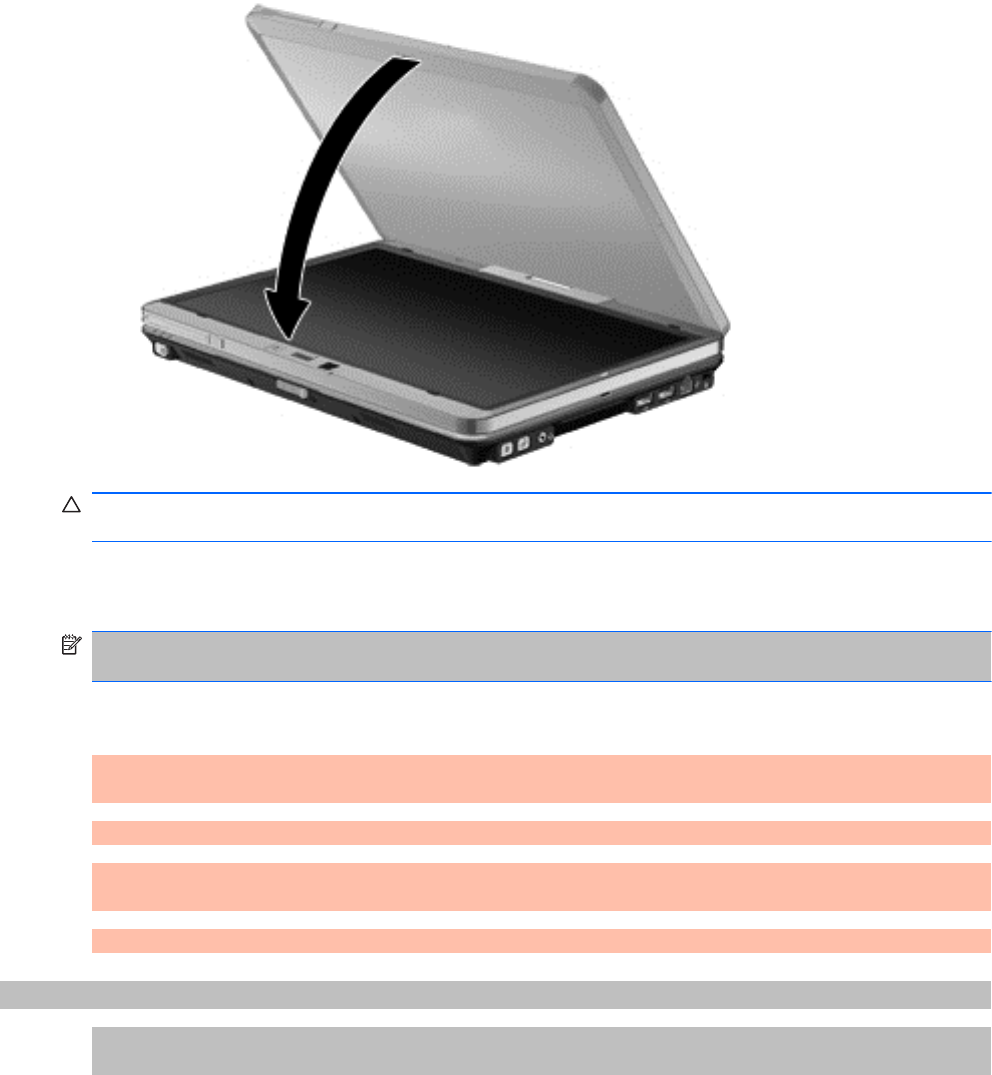
3. Lower the display over the keyboard.
CAUTION: To reduce the risk of damage to your computer, do not transport the computer while it is
in slate mode.
Using pointing devices
NOTE: In addition to the pointing devices included with your computer, you can use an external
USB mouse (purchased separately) by connecting it to one of the USB ports on the computer.
Setting pointing device preferences
Use Mouse Properties in Windows to customize settings for pointing devices, such as button
configuration, click speed, and pointer options.
To access Mouse Properties:
Windows 7—Select Start > Devices and Printers. Then right-click the device representing your
computer, and select Mouse settings.
Windows Vista—Select Start > Control Panel > Hardware and Sound > Mouse.
Using the pointing stick
Press the pointing stick in the direction you want to move the pointer on the screen. Use the left and
right pointing stick buttons as you would the left and right buttons on an external mouse.
Using the TouchPad
To move the pointer, slide one finger across the TouchPad in the direction you want the pointer to go.
Use the left and right TouchPad buttons like the buttons on an external mouse. To scroll up and down
using the TouchPad vertical scroll zone, slide your finger up or down over the lines.
28 Chapter 5 Keyboard and pointing devices

NOTE: If you are using the TouchPad to move the pointer, you must lift your finger off the
TouchPad before moving it to the scroll zone. Simply sliding your finger from the TouchPad to the
scroll zone does not activate the scrolling function.
Using pointing devices 29
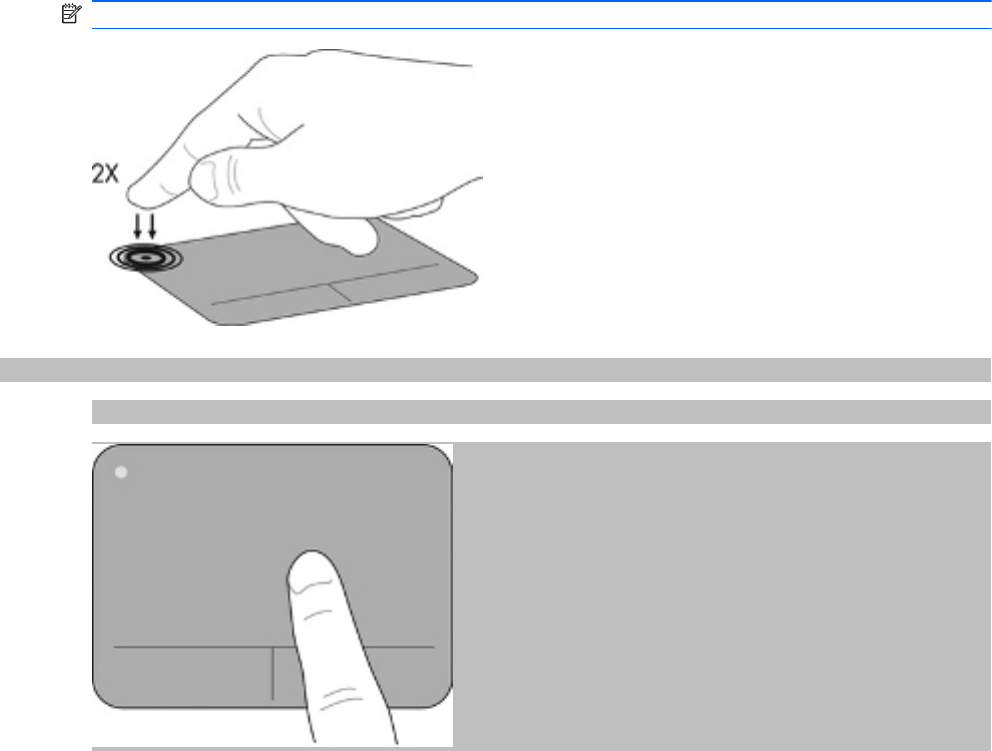
Turning the TouchPad off and on
To turn the TouchPad off and on, quickly double-tap the TouchPad light.
NOTE: The TouchPad light is off when the TouchPad is on.
Navigating
To move the pointer, slide one finger across the TouchPad in the direction you want the pointer to go.
30 Chapter 5 Keyboard and pointing devices
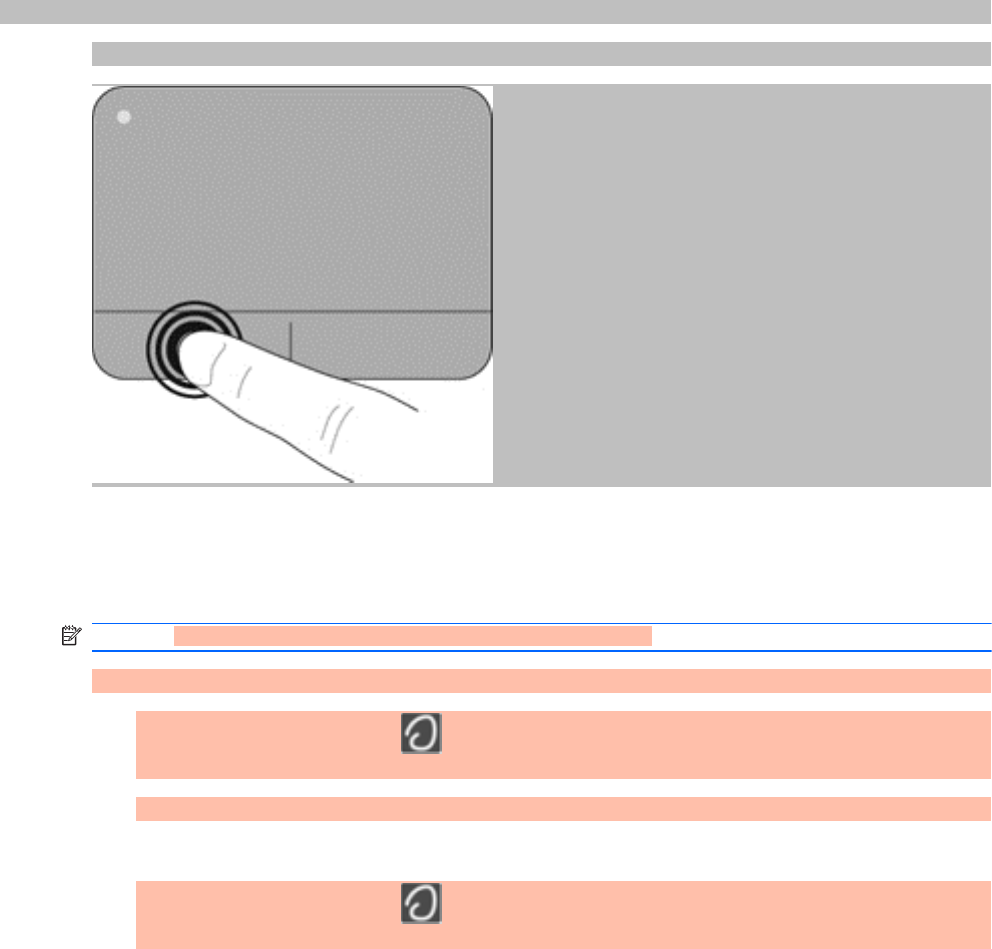
Selecting
Use the left and right TouchPad buttons like the corresponding buttons on an external mouse.
Using TouchPad gestures
The TouchPad supports a variety of gestures. To use TouchPad gestures, place two fingers on the
TouchPad at the same time.
NOTE: TouchPad gestures are not supported in all programs.
To view the demonstration of a gesture:
1. Right-click the Synaptics icon in the notification area, at the far right of the taskbar, and
then click TouchPad Properties.
2. Click a gesture to activate the demonstration.
To turn the gestures on and off:
1. Right-click the Synaptics icon in the notification area, at the far right of the taskbar, and
then click TouchPad Properties.
2. Select the gesture that you want to turn on or off.
3. Click Apply, and then click OK.
Using pointing devices 31
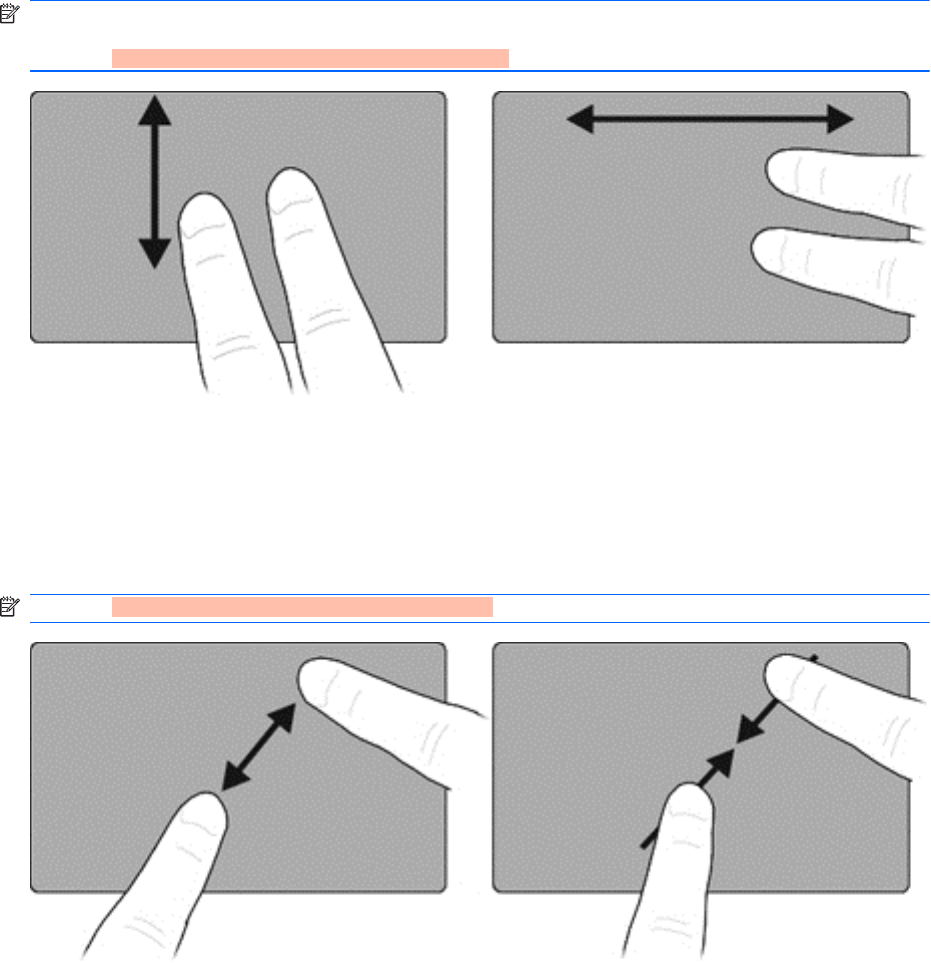
Scrolling
Scrolling is useful for moving up, down, or sideways on a page or image. To scroll, place two fingers
slightly apart on the TouchPad, and then drag them across the TouchPad in an up, down, left, or right
motion.
NOTE: Scrolling speed is controlled by finger speed.
NOTE: Two-finger scrolling is enabled at the factory.
Pinching/Zooming
Pinching allows you to zoom in or out on images or text.
●Zoom in by placing two fingers together on the TouchPad, and then moving them apart.
●Zoom out by placing two fingers apart on the TouchPad, and then moving them together.
NOTE: Pinching/zooming is enabled at the factory.
32 Chapter 5 Keyboard and pointing devices
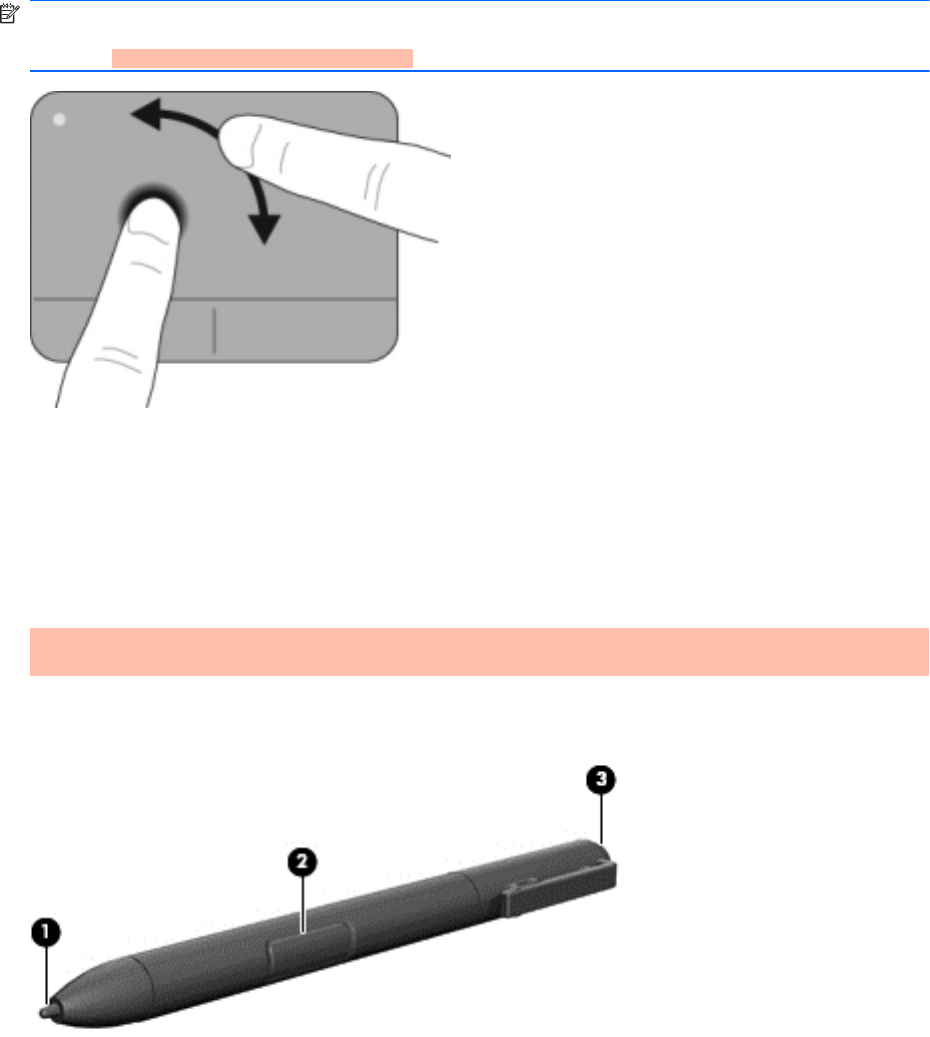
Rotating
Rotating allows you to rotate items such as photos. To rotate, anchor your left forefinger in the
TouchPad zone. Move the right forefinger around the anchored finger in a sweeping motion, moving
from 12 o’clock to 3 o’clock. To reverse the rotation, move your right forefinger from 3 o’clock to 12
o’clock.
NOTE: Rotating must be done within the TouchPad zone.
NOTE: Rotating is disabled at the factory.
Using the digitizer pen
You can write with the pen in pen-specific programs such as Tablet PC Input Panel, in all Microsoft®
Office programs, and in many other Windows programs and utilities. The information you write on the
screen with the pen can be filed, searched, and shared among the programs.
Identifying the pen components
The pen interacts with the computer whenever the tip (1) or eraser (3) of the pen is pressed against
the screen.
The pen tether eyelet (2) allows you to connect a tether from the pen to the pen tether hole on the
computer.
Holding the pen
Hold the pen as if you were writing with a standard pen or pencil.
Using pointing devices 33
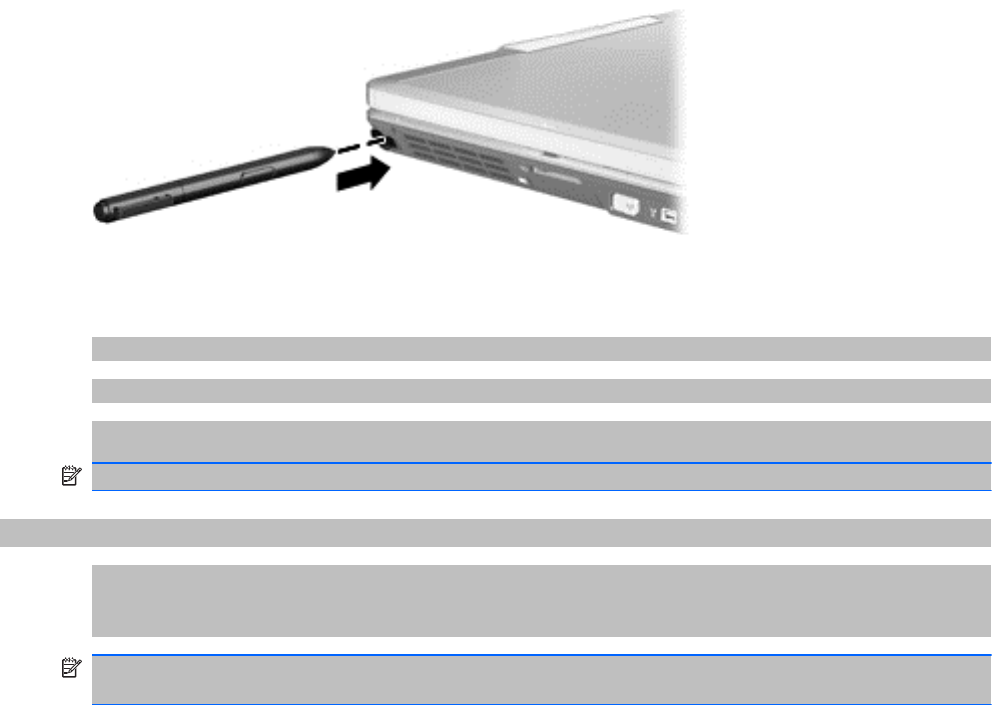
Storing the pen
To store the pen when you are not using it, insert the pen, tip first, into the pen holder on the
computer.
Using touch screen gestures
You can use your fingers or the digitizer pen on the touch screen.
To modify gestures on the touch screen:
▲Select Start > Control Panel > Hardware and Sound > Pen and Touch.
NOTE: Not all gestures are supported in all programs.
Tapping (or clicking)
Tap or double-tap an item on the screen as you would click or double-click with the TouchPad or an
external mouse. Tap and hold an item to see the context menu as you would with the right TouchPad
button.
NOTE: You must tap and hold your finger until a circle appears around the area you are touching,
and then the context menu appears.
34 Chapter 5 Keyboard and pointing devices
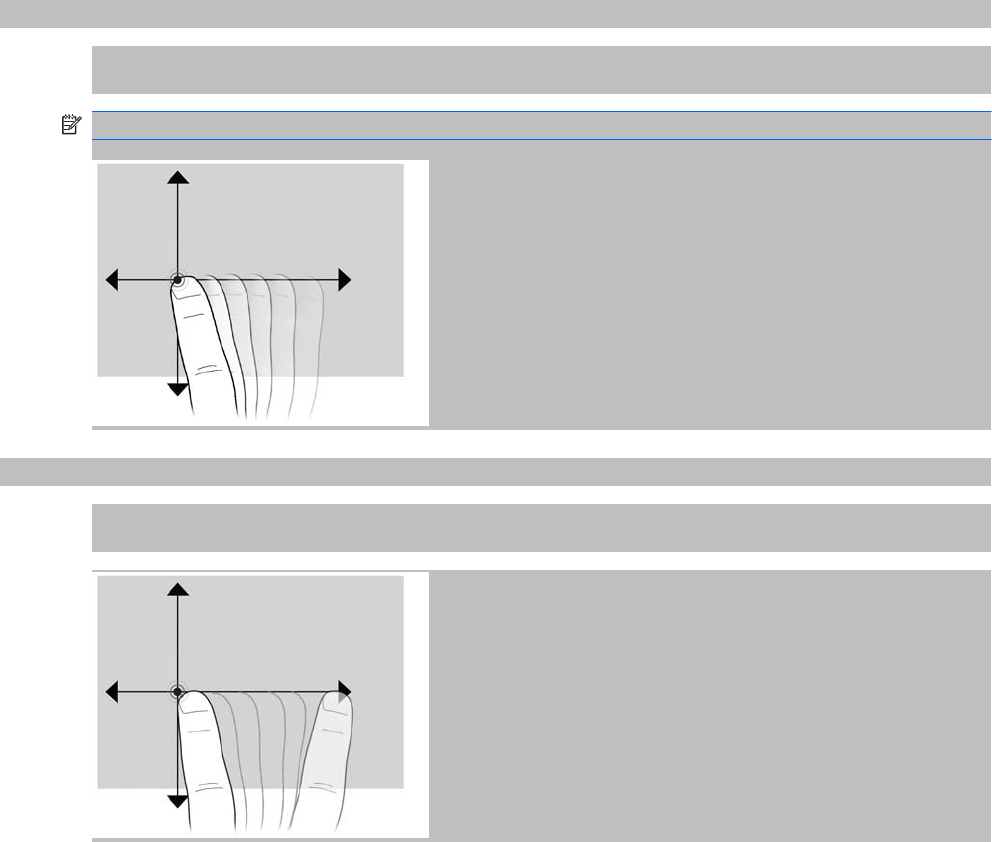
Flicking
Touch the screen in a light, quick flicking motion up, down, left, or right to navigate through screens or
quickly scroll through documents.
NOTE: For the flick movement to work, a scrollbar must be present in the active window.
Dragging
Press your finger on an item on the screen, and then move your finger to drag the item to a new
location. You can also use this motion to slowly scroll through documents.
Using touch screen gestures 35
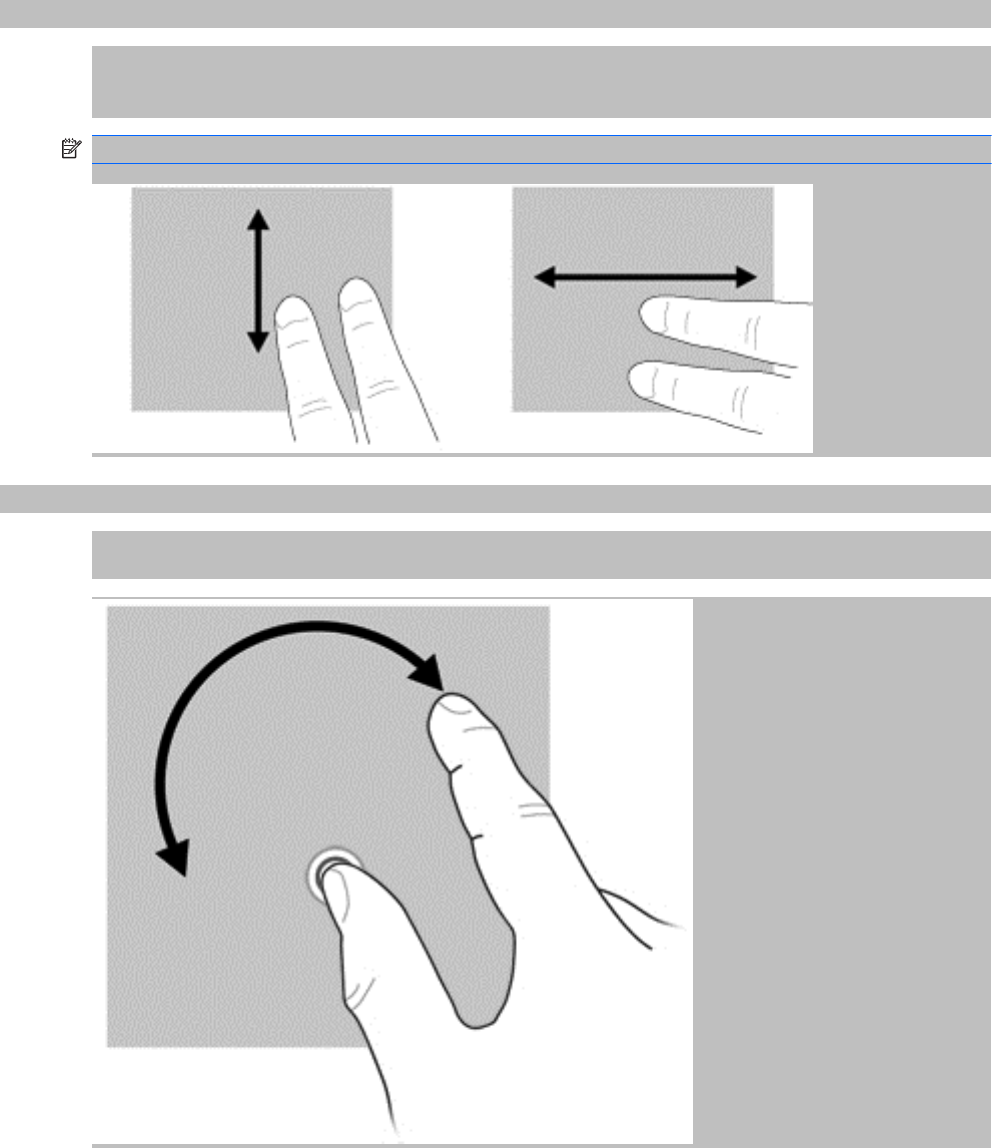
Scrolling
Scrolling is useful for moving up, down, or sideways on a page or image. To scroll, place two fingers
slightly apart on the screen, and then drag them across the screen in an up, down, left, or right
motion.
NOTE: Scrolling speed is controlled by finger speed.
Rotating
Rotating allows you rotate items such as photos. To rotate, anchor your thumb on the screen, and
then move your forefinger in a semicircular motion around your thumb.
36 Chapter 5 Keyboard and pointing devices
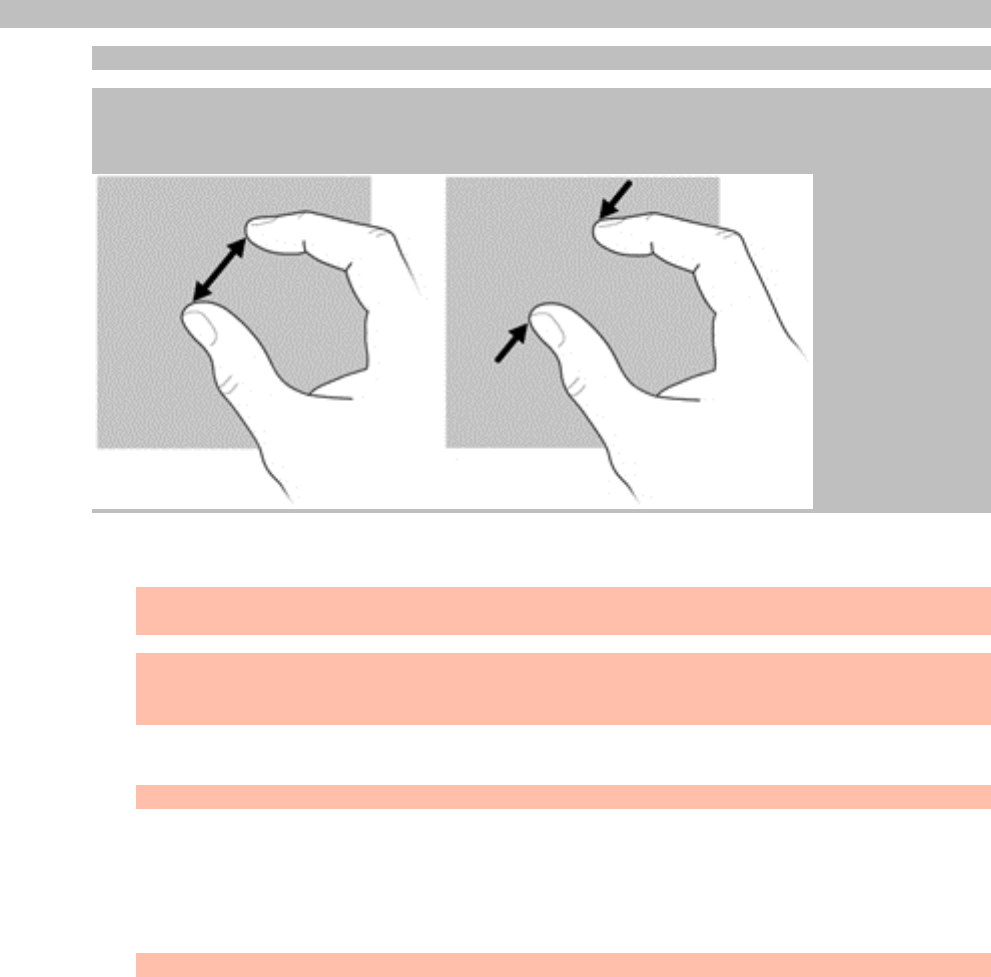
Pinching/Zooming
Pinching allows you to zoom in or out an item.
●Zoom in by holding two fingers together on the screen, and then pull the fingers apart.
●Zoom out by holding two fingers apart on the screen, and then pull the fingers together.
Setting touch screen preferences
▲To set preferences, select Start > Control Panel > Hardware and Sound > Pen and Touch.
These preferences are specific to the touch screen and the computer.
▲To set preferences for left-handed or right-handed users, select Start > Control Panel >
Hardware and Sound > Tablet PC Settings > Other tab. These preferences are specific to the
touch screen and the computer.
To change or test click settings:
1. Select Start > Control Panel > Hardware and Sound> Pen and Touch > Pen Options tab.
2. Under Pen Actions, select the action, and then click Settings.
3. After making any changes or testing the settings, click OK.
To change or create flick assignments:
1. Select Start > Control Panel > Hardware and Sound> Pen and Touch > Flicks tab.
2. Click Navigational flicks and editing flicks, and then click Customize.
3. Follow the on-screen instructions to change or create a flick assignment.
4. Click OK.
Using touch screen gestures 37
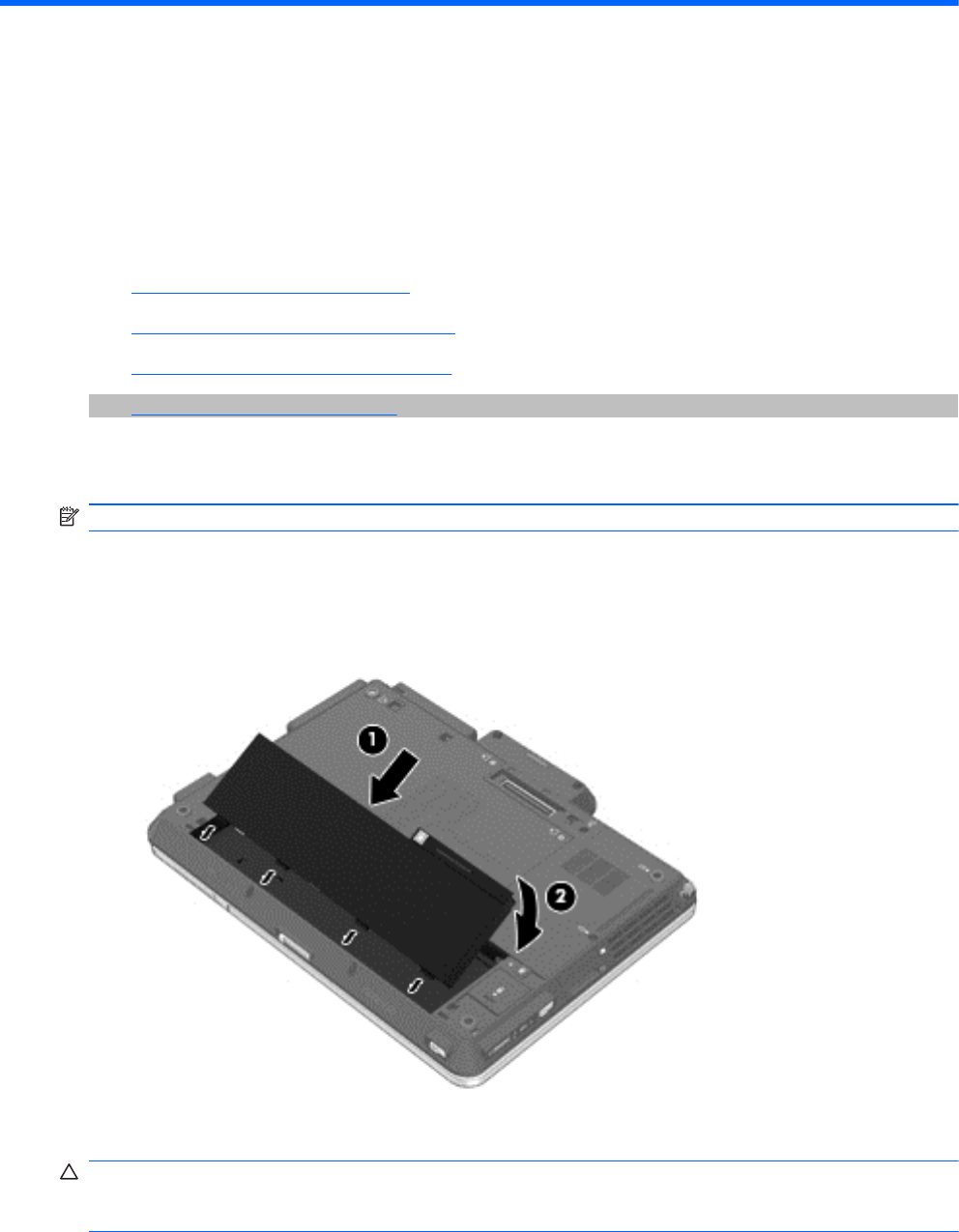
6 Maintenance
●Inserting or removing the battery
●Replacing or upgrading the hard drive
●Adding or replacing memory modules
●Updating programs and drivers
Inserting or removing the battery
NOTE: For additional information on using the battery, refer to the HP Notebook Reference Guide.
To insert the battery:
▲Insert the battery (1) into the battery bay until it is seated.
The battery release latch (2) automatically locks the battery into place.
To remove the battery:
CAUTION: Removing a battery that is the sole power source for the computer can cause loss of
information. To prevent loss of information, save your work and initiate Hibernation or shut down the
computer through Windows before removing the battery.
1. Slide the battery release latch (1) to release the battery.
38 Chapter 6 Maintenance
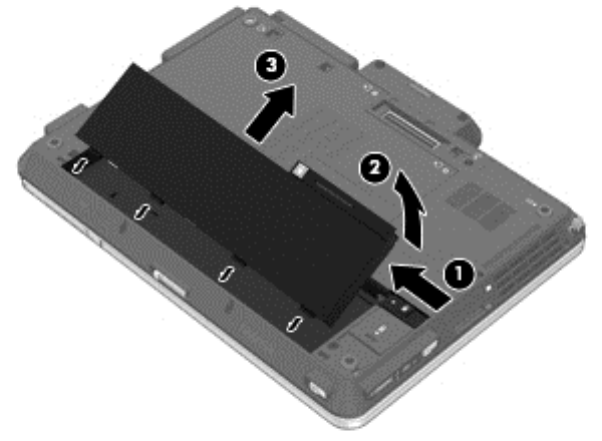
2. Remove the battery from the computer (2).
Inserting or removing the battery 39
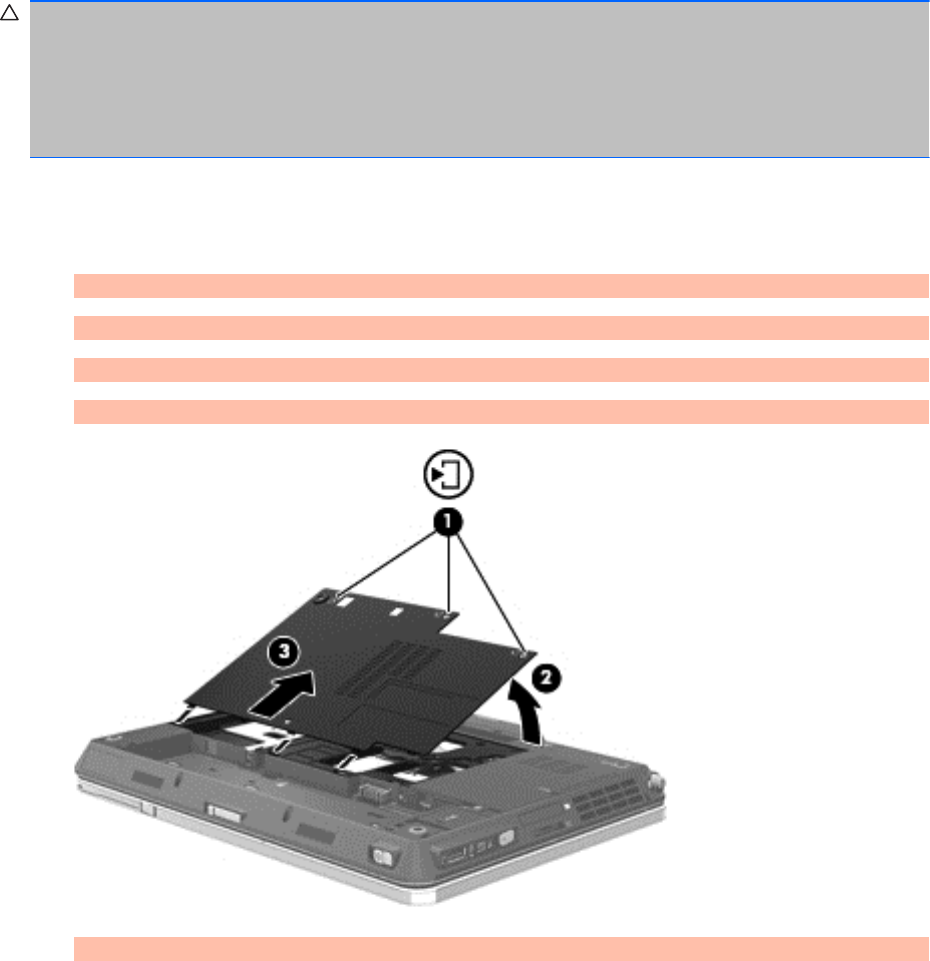
Replacing or upgrading the hard drive
CAUTION: To prevent information loss or an unresponsive system:
Shut down the computer before removing the hard drive from the hard drive bay. Do not remove the
hard drive while the computer is on, in the Sleep state, or in Hibernation.
If you are not sure whether the computer is off or in Hibernation, turn the computer on by pressing the
power button. Then shut down the computer through the operating system.
Removing the hard drive
1. Save your work and shut down the computer.
2. Disconnect AC power and external devices connected to the computer.
3. Remove the battery.
4. Loosen the 3 service cover screws (1).
5. Remove the service cover (2).
6. Grasp the tab on the hard drive (1) and pull forward (2) to disconnect the hard drive.
40 Chapter 6 Maintenance
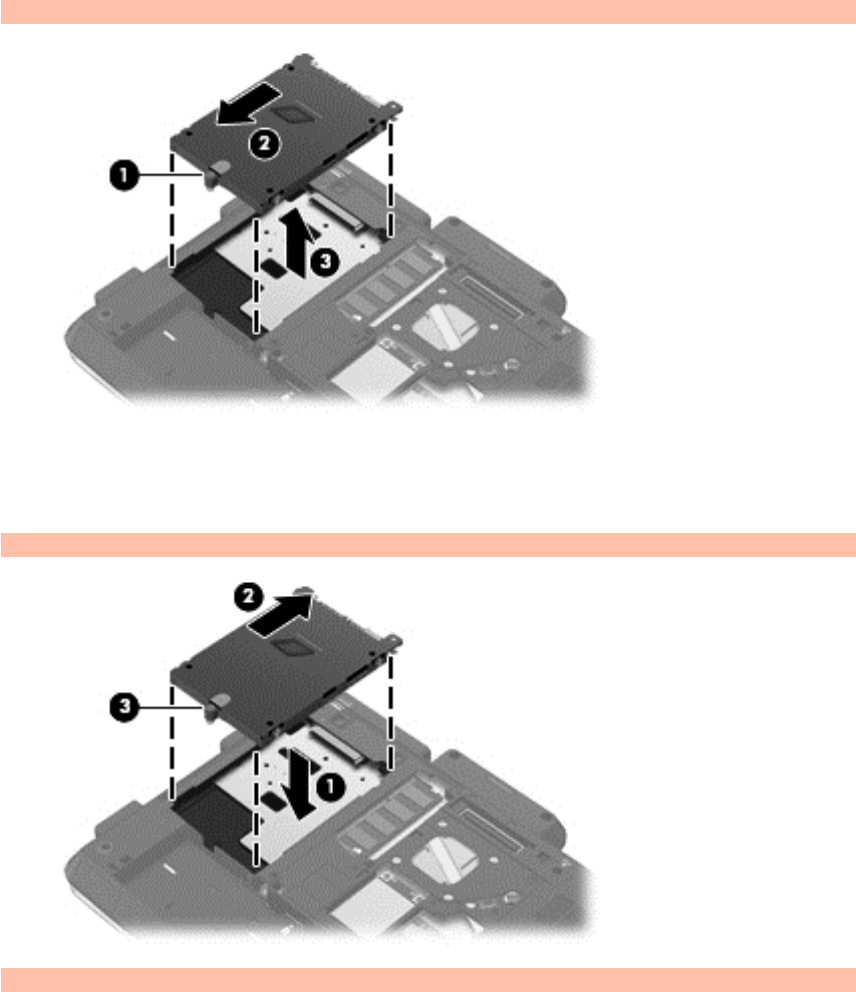
7. Lift the hard drive (3) out of the hard drive bay.
Installing a hard drive
1. Insert the hard drive into the hard drive bay (1).
2. Pull the hard drive tab (2) to the right until the hard drive snaps into place (3).
3. Align the tabs (1) on the service cover with the notches on the computer.
4. Close the cover (2).
Replacing or upgrading the hard drive 41
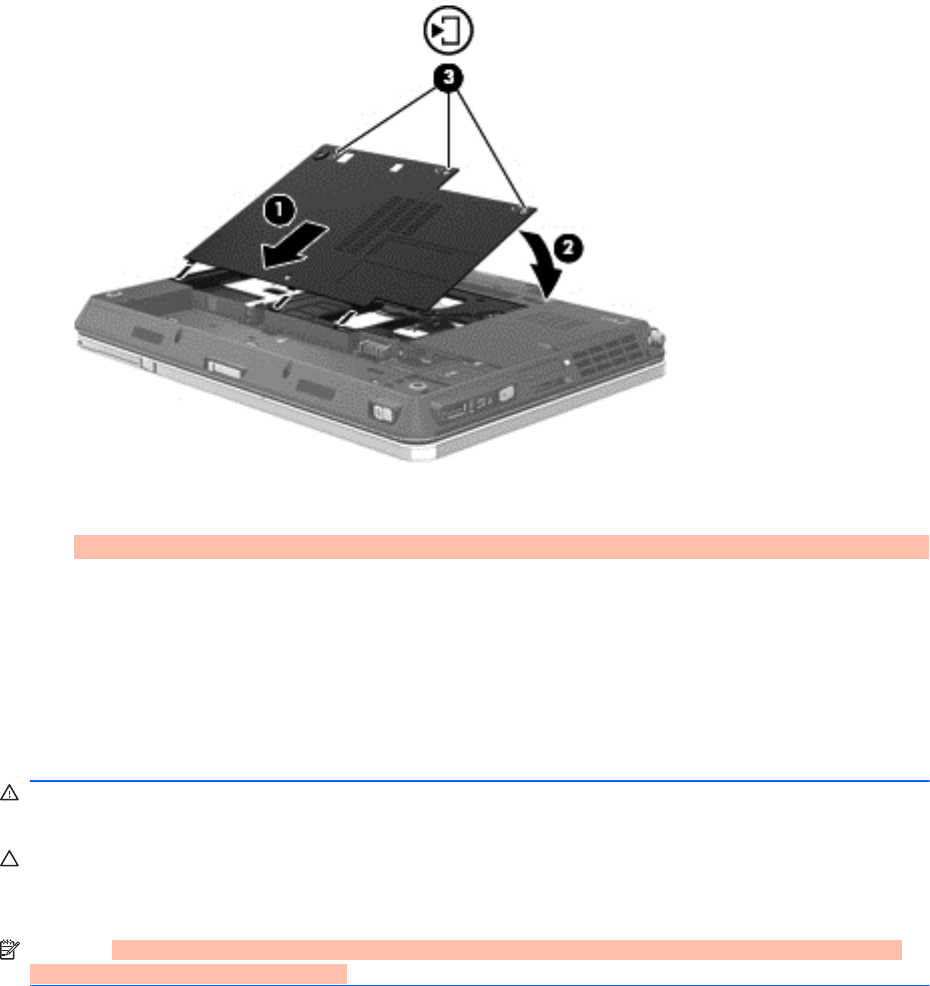
5. Tighten the hard drive cover screws (3).
6. Replace the battery.
7. Connect AC power and external devices to the computer.
8. Turn on the computer.
Adding or replacing memory modules
The computer has two memory module compartments. The capacity of the computer can be
upgraded by adding a memory module to the vacant expansion memory module slot or by upgrading
the existing memory module in the primary memory module slot.
WARNING! To reduce the risk of electric shock and damage to the equipment, unplug the power
cord and remove all batteries before installing a memory module.
CAUTION: Electrostatic discharge (ESD) can damage electronic components. Before beginning
any procedure, ensure that you are discharged of static electricity by touching a grounded metal
object.
NOTE: To use a dual-channel configuration when adding a second memory module, be sure that
both memory modules are identical.
To add or replace a memory module:
42 Chapter 6 Maintenance
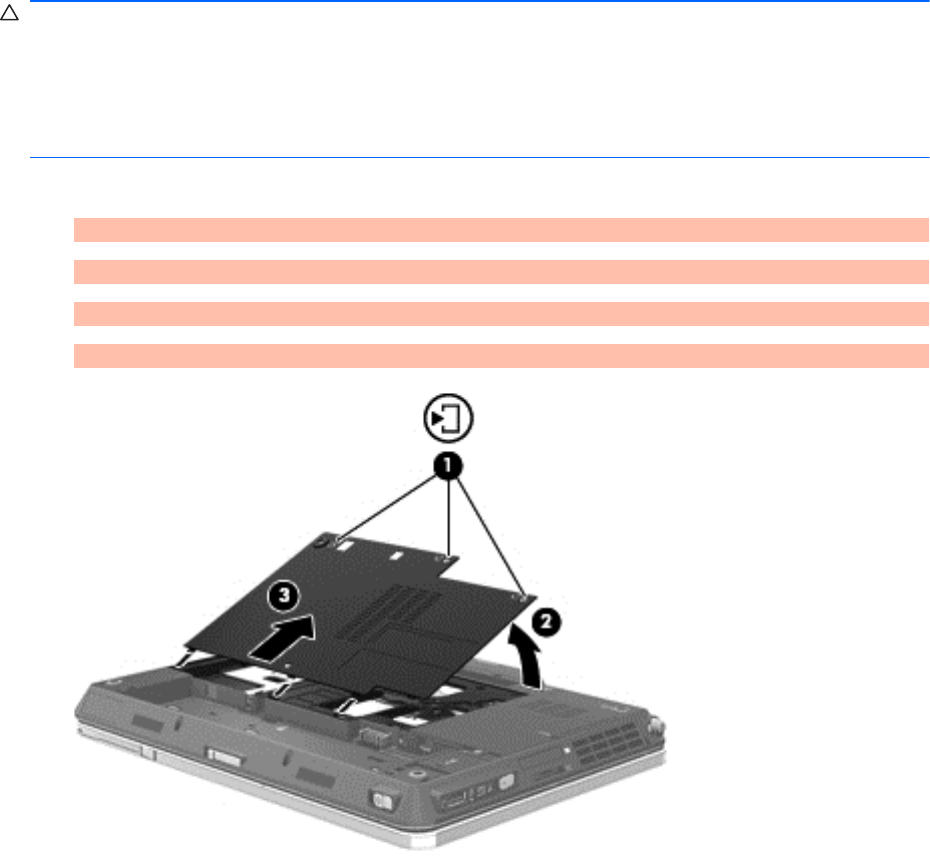
CAUTION: To prevent information loss or an unresponsive system:
Shut down the computer before adding or replacing memory modules. Do not remove a memory
module while the computer is on, in the Sleep state, or in Hibernation.
If you are not sure whether the computer is off or in Hibernation, turn the computer on by pressing the
power button. Then shut down the computer through the operating system.
1. Save your work and shut down the computer.
2. Disconnect AC power and external devices connected to the computer.
3. Remove the battery.
4. Loosen the 3 service cover screws (1).
5. Remove the service cover (2).
6. If you are replacing a memory module, remove the existing memory module:
a. Pull away the retention clips (1) on each side of the memory module.
The memory module tilts up.
Adding or replacing memory modules 43
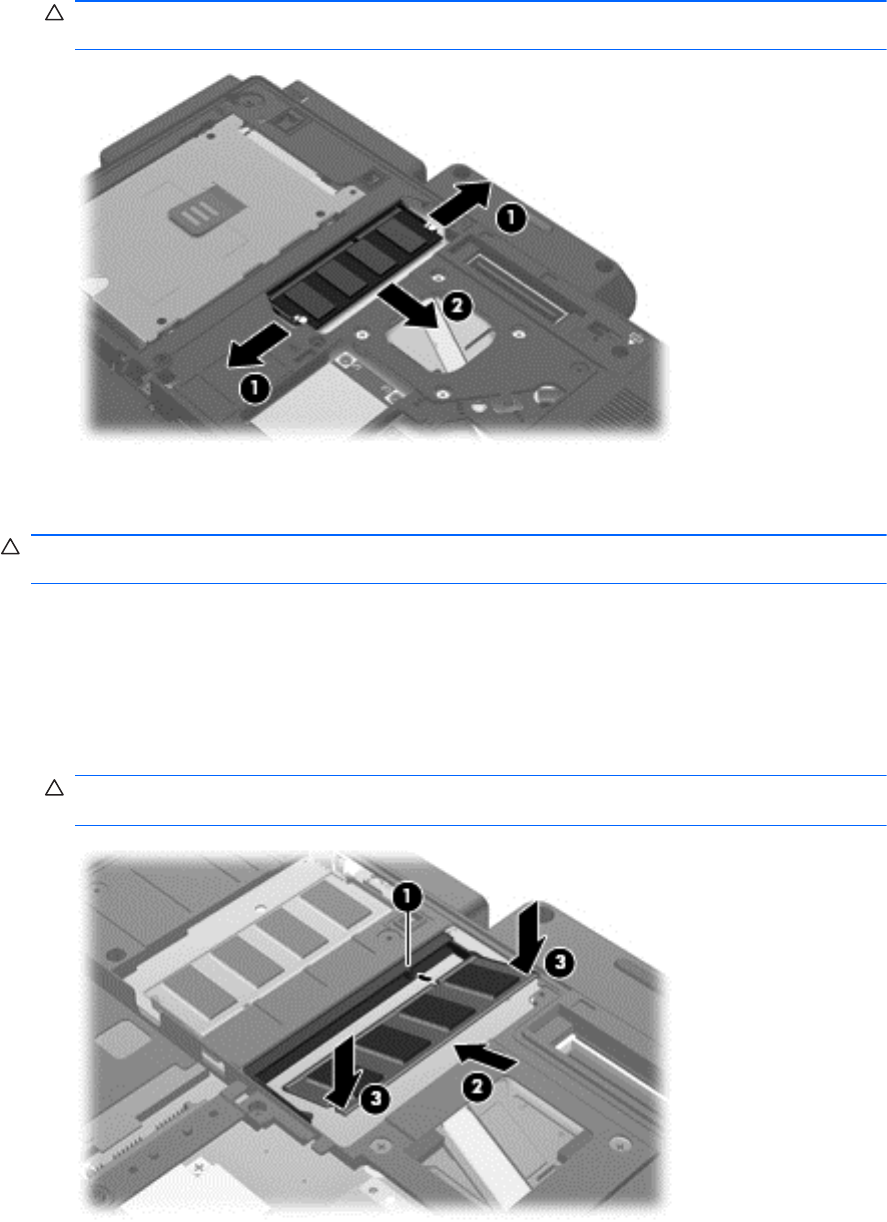
b. Grasp the edge of the memory module (2), and then gently pull the memory module out of
the memory module slot.
CAUTION: To prevent damage to the memory module, hold the memory module by the
edges only. Do not touch the components on the memory module.
To protect a memory module after removal, place it in an electrostatic-safe container.
7. Insert a new memory module:
CAUTION: To prevent damage to the memory module, hold the memory module by the edges
only. Do not touch the components on the memory module.
a. Align the notched edge (1) of the memory module with the tab in the memory module slot.
b. With the memory module at a 45-degree angle from the surface of the memory module
compartment, press the module (2) into the memory module slot until it is seated.
c. Gently press the memory module (3) down, applying pressure to both the left and right
edges of the memory module, until the retention clips snap into place.
CAUTION: To prevent damage to the memory module, be sure that you do not bend the
memory module.
44 Chapter 6 Maintenance
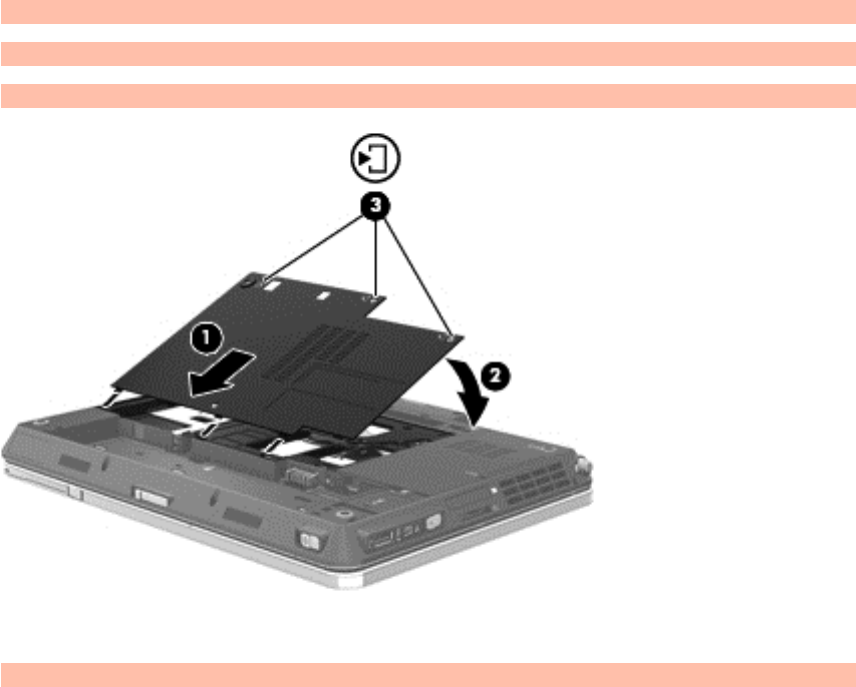
8. Align the tabs (1) on the service cover with the notches on the computer.
9. Close the cover (2).
10. Tighten the hard drive cover screws (3).
11. Replace the battery.
12. Connect AC power and external devices to the computer.
13. Turn on the computer.
Adding or replacing memory modules 45

Updating programs and drivers
HP recommends that you update your programs and drivers on a regular basis with the latest
versions. Go to http://www.hp.com/support to download the latest versions. You can also register to
receive automatic update notifications when they become available.
46 Chapter 6 Maintenance

7 Backup and recovery
Windows 7
●Backing up your information
●Performing a system recovery
To protect your information, use Windows Backup and Restore to back up individual files and folders,
back up your entire hard drive (select models only), create system repair discs (select models only)
by using the installed optical drive (select models only) or an optional external optical drive, or create
system restore points. In case of system failure, you can use the backup files to restore the contents
of your computer.
Windows Backup and Restore provides the following options:
●Creating a system repair disc (select models only) by using the installed optical drive (select
models only) or an optional external optical drive
●Backing up your information
●Creating a system image (select models only)
●Scheduling automatic backups (select models only)
●Creating system restore points
●Recovering individual files
●Restoring the computer to a previous state
●Recovering information using recovery tools
NOTE: For detailed instructions, perform a search for these topics in Help and Support.
In case of system instability, HP recommends that you print the recovery procedures and save them
for later use.
NOTE: Windows includes the User Account Control feature to improve the security of your
computer. You may be prompted for your permission or password for tasks such as installing
software, running utilities, or changing Windows settings. Refer to Help and Support for more
information.
Backing up your information
Recovery after a system failure is as good as your most recent backup. You should create system
repair discs (select models only) by using the installed optical drive (select models only) or an
optional external optical drive, and your initial backup immediately after software setup. As you add
Windows 7 47

new software and data files, you should continue to back up your system on a regular basis to
maintain a reasonably current backup. The system repair discs (select models only) are used to start
up (boot) the computer and repair the operating system in case of system instability or failure. Your
initial and subsequent backups allow you to restore your data and settings if a failure occurs.
You can back up your information to an optional external hard drive, a network drive, or discs.
Note the following when backing up:
●Store personal files in the Documents library, and back it up regularly.
●Back up templates that are stored in their associated programs.
●Save customized settings that appear in a window, toolbar, or menu bar by taking a screen shot
of your settings. The screen shot can be a time-saver if you have to reset your preferences.
●When backing up to discs, use any of the following types of discs (purchased separately): CD-R,
CD-RW, DVD+R, DVD+R DL, DVD-R, DVD-R DL, or DVD±RW. The discs you use will depend
on the type of optical drive installed in your computer or the type of external optical drive you are
using.
NOTE: DVDs and DVDs with double-layer (DL) support store more information than CDs, so
using them for backup reduces the number of recovery discs required.
●When backing up to discs, number each disc before inserting it into the optical drive of the
computer.
To create a backup using Backup and Restore:
NOTE: Be sure that the computer is connected to AC power before you start the backup process.
NOTE: The backup process may take over an hour, depending on file size and the speed of the
computer.
1. Select Start > All Programs > Maintenance > Backup and Restore.
2. Follow the on-screen instructions to set up your backup, create a system image (select models
only), or create a system repair disc (select models only).
Performing a system recovery
In case of system failure or instability, the computer provides the following tools to recover your files:
●Windows recovery tools: You can use Windows Backup and Restore to recover information you
have previously backed up. You can also use Windows Startup Repair to fix problems that might
prevent Windows from starting correctly.
●f11 recovery tools: You can use the f11 recovery tools to recover your original hard drive image.
The image includes the Windows operating system and software programs installed at the
factory.
NOTE: If you are unable to boot (start up) your computer and you cannot use the system repair
discs you previously created (select models only), you must purchase a Windows 7 operating system
DVD to reboot the computer and repair the operating system. For additional information, refer to
Using a Windows 7 operating system DVD (purchased separately) on page 50.
48 Chapter 7 Backup and recovery

Using the Windows recovery tools
To recover information you previously backed up:
1. Select Start > All Programs > Maintenance > Backup and Restore.
2. Follow the on-screen instructions to recover your system settings, your computer (select models
only), or your files.
To recover your information using Startup Repair, follow these steps:
CAUTION: Using Startup Repair completely erases hard drive contents and reformats the hard
drive. All files you have created and any software installed on the computer are permanently
removed. When reformatting is complete, the recovery process restores the operating system, as well
as the drivers, software, and utilities from the backup used for recovery.
1. If possible, back up all personal files.
2. If possible, check for the presence of the Windows partition and the HP Recovery partition.
To check for the Windows partition, select Start > Computer.
To check for the HP Recovery partition, click Start, right-click Computer, click Manage, and
then click Disk Management.
NOTE: If the Windows partition and the HP Recovery partition are not listed, you must recover
your operating system and programs using the Windows 7 operating system DVD and the Driver
Recovery disc (both purchased separately). For additional information, refer to Using a Windows
7 operating system DVD (purchased separately) on page 50.
3. If the Windows partition and the HP Recovery partition are listed, restart the computer, and then
press f8 before the Windows operating system loads.
4. Select Startup Repair.
5. Follow the on-screen instructions.
NOTE: For additional information on recovering information using the Windows tools, perform a
search for these topics in Help and Support.
Using f11 recovery tools
CAUTION: Using f11 completely erases hard drive contents and reformats the hard drive. All files
you have created and any software installed on the computer are permanently removed. The f11
recovery tool reinstalls the operating system and HP programs and drivers that were installed at the
factory. Software not installed at the factory must be reinstalled.
To recover the original hard drive image using f11:
1. If possible, back up all personal files.
2. If possible, check for the presence of the HP Recovery partition: click Start, right-click
Computer, click Manage, and then click Disk Management.
NOTE: If the HP Recovery partition is not listed, you must recover your operating system and
programs using the Windows 7 operating system DVD and the Driver Recovery disc (both
purchased separately). For additional information, refer to Using a Windows 7 operating system
DVD (purchased separately) on page 50.
Windows 7 49

3. If the HP Recovery partition is listed, restart the computer, and then press esc while the “Press
the ESC key for Startup Menu” message is displayed at the bottom of the screen.
4. Press f11 while the “Press <F11> for recovery” message is displayed on the screen.
5. Follow the on-screen instructions.
Using a Windows 7 operating system DVD (purchased separately)
To order a Windows 7 operating system DVD, go to http://www.hp.com/support, select your country
or region, and follow the on-screen instructions. You can also order the DVD by calling technical
support. For contact information, refer to the Worldwide Telephone Numbers booklet included with
the computer.
CAUTION: Using a Windows 7 operating system DVD completely erases hard drive contents and
reformats the hard drive. All files you have created and any software installed on the computer are
permanently removed. When reformatting is complete, the recovery process helps you restore the
operating system, as well as drivers, software, and utilities.
To initiate recovery using a Windows 7 operating system DVD:
NOTE: This process takes several minutes.
1. If possible, back up all personal files.
2. Restart the computer, and then insert the Windows 7 operating system DVD into the optical
drive before the Windows operating system loads.
3. When prompted, press any keyboard key.
4. Follow the on-screen instructions.
5. Click Next.
6. Select Repair your computer.
7. Follow the on-screen instructions.
50 Chapter 7 Backup and recovery

Windows Vista
To protect your information, use the Backup and Restore Center to back up individual files and
folders, back up your entire hard drive (select models only), or create system restore points. In case
of system failure, you can use the backup files to restore the contents of your computer.
The Backup and Restore Center provides the following options:
●Backing up individual files and folders
●Backing up the entire hard drive (select models only)
●Scheduling automatic backups (select models only)
●Creating system restore points
●Recovering individual files
●Restoring the computer to a previous state
●Recovering information using recovery tools
NOTE: For detailed instructions, perform a search for these topics in Help and Support.
NOTE: In case of system instability, HP recommends that you print the recovery procedures and
save them for later use.
NOTE: Windows® includes the User Account Control feature to improve the security of your
computer. You may be prompted for your permission or password for tasks such as installing
software, running utilities, or changing Windows settings. Refer to Help and Support for more
information.
Backing up your information
Recovery after a system failure is as complete as your most current backup. You should create your
initial backup immediately after software setup. As you add new software and data files, you should
continue to back up your system on a regular basis to maintain a reasonably current backup.
You can back up your information to an optional external hard drive, a network drive, or discs.
Note the following when backing up:
●Store personal files in the Documents folder, and back it up regularly.
●Back up templates that are stored in their associated programs.
●Save customized settings that appear in a window, toolbar, or menu bar by taking a screen shot
of your settings. The screen shot can be a time-saver if you have to reset your preferences.
●When backing up to discs, use any of the following types of discs (purchased separately): CD-R,
CD-RW, DVD+R, DVD+R DL, DVD-R, DVD-R DL, or DVD±RW. The discs you use will depend
on the type of optical drive installed in your computer.
NOTE: DVDs and DVDs with double-layer (DL) support store more information than CDs, so
using them for backup reduces the number of recovery discs required.
●When backing up to discs, number each disc before inserting it into the optical drive of the
computer.
Windows Vista 51

To create a backup using Backup and Restore Center:
NOTE: Be sure that the computer is connected to AC power before you start the backup process.
NOTE: The backup process may take over an hour, depending on file size and the speed of the
computer.
1. Select Start > All Programs > Maintenance > Backup and Restore Center.
2. Follow the on-screen instructions to back up your entire computer (select models only) or your
files.
Performing a recovery
In case of system failure or instability, the computer provides the following tools to recover your files:
●Windows recovery tools: You can use the Backup and Restore Center to recover information
you have previously backed up. You can also use Windows Startup Repair to fix problems that
might prevent Windows from starting correctly.
●f11 recovery tools: You can use the f11 recovery tools to recover your original hard drive image.
The image includes the Windows operating system and software programs installed at the
factory.
NOTE: If you are unable to boot (start up) your computer, you must purchase a Windows Vista®
operating system DVD to reboot the computer and repair the operating system. For additional
information, refer to Using a Windows Vista operating system DVD (purchased separately)
on page 53.
Using the Windows recovery tools
To recover information you previously backed up:
1. Select Start > All Programs > Maintenance > Backup and Restore Center.
2. Follow the on-screen instructions to recover your entire computer (select models only) or your
files.
To recover your information using Startup Repair, follow these steps:
CAUTION: Using Startup Repair completely erases hard drive contents and reformats the hard
drive. All files you have created and any software installed on the computer are permanently
removed. When reformatting is complete, the recovery process restores the operating system, as well
as the drivers, software, and utilities from the backup used for recovery.
1. If possible, back up all personal files.
2. If possible, check for the presence of the Windows partition and the HP Recovery partition. To
find the partitions, select Start > Computer.
NOTE: If the Windows partition and the HP Recovery partition have been deleted, you must
recover your operating system and programs using the Windows Vista operating system DVD
and the Driver Recovery disc (both purchased separately). For additional information, refer to
Using a Windows Vista operating system DVD (purchased separately) on page 53.
3. Restart the computer, and then press f8 before the Windows operating system loads.
52 Chapter 7 Backup and recovery

4. Select Repair your computer.
5. Follow the on-screen instructions.
NOTE: For additional information on recovering information using the Windows tools, perform a
search for these topics in Help and Support.
Using f11 recovery tools
CAUTION: Using f11 completely erases hard drive contents and reformats the hard drive. All files
you have created and any software installed on the computer are permanently removed. The f11
recovery tool reinstalls the operating system and HP programs and drivers that were installed at the
factory. Software not installed at the factory must be reinstalled. Personal files must be restored from
a backup.
NOTE: If your computer includes a solid-state drive (SSD), you may not have a recovery partition.
Recovery discs have been included for computers that do not have a partition. Use these discs to
recover your operating system and software. To check for the presence of a recovery partition, select
Start > Computer. If the partition is present, an HP Recovery drive is listed in the Hard Disk Drives
section of the window.
To recover the original hard drive image using f11, follow these steps:
1. If possible, back up all personal files.
2. If possible, check for the presence of the HP Recovery partition. To find the partition, select
Start > Computer.
NOTE: If the HP Recovery partition has been deleted, you must recover your operating system
and programs using the Windows Vista operating system DVD and the Driver Recovery disc
(both purchased separately). For additional information, refer to Using a Windows Vista
operating system DVD (purchased separately) on page 53.
3. Turn on or restart the computer, and then press esc while the “Press the ESC key for Startup
Menu” message is displayed at the bottom of the screen.
4. Press f11 while the “Press <F11> for recovery” message is displayed on the screen.
5. Follow the on-screen instructions.
Using a Windows Vista operating system DVD (purchased separately)
To order a Windows Vista operating system DVD, go to http://www.hp.com/support, select your
country or region, and follow the on-screen instructions. You can also order the DVD by calling
technical support. For contact information, refer to the Worldwide Telephone Numbers booklet
included with the computer.
CAUTION: Using a Windows Vista operating system DVD completely erases hard drive contents
and reformats the hard drive. All files you have created and any software installed on the computer
are permanently removed. When reformatting is complete, the recovery process helps you restore the
operating system, as well as drivers, software, and utilities.
To initiate recovery using a Windows Vista operating system DVD:
Windows Vista 53

NOTE: This process takes several minutes.
1. If possible, back up all personal files.
2. Restart the computer, and then insert the Windows Vista operating system DVD into the optical
drive before the Windows operating system loads.
3. When prompted, press any keyboard key.
4. Follow the on-screen instructions.
5. Click Next.
6. Select Repair your computer.
7. Follow the on-screen instructions.
54 Chapter 7 Backup and recovery

Contacting customer support
If the information provided in this user guide, in the HP Notebook Reference Guide, or in Help and
Support does not address your questions, you can contact HP Customer Support at:
http://www.hp.com/go/contactHP
NOTE: For worldwide support, click Contact HP worldwide on the left side of the page, or go to
http://welcome.hp.com/country/us/en/wwcontact_us.html.
Here you can:
●Chat online with an HP technician.
NOTE: When technical support chat is not available in a particular language, it is available in
English.
●E-mail HP Customer Support.
●Find HP Customer Support worldwide telephone numbers.
●Locate an HP service center.
56 Chapter 8 Customer support
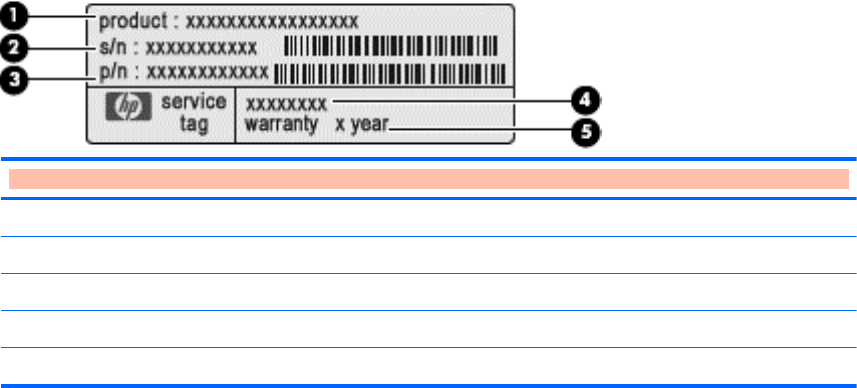
Labels
The labels affixed to the computer provide information you may need when you troubleshoot system
problems or travel internationally with the computer:
●Serial number label—Provides important information, including the following:
Component
(1) Product name
(2) Serial number (s/n)
(3) Part number/Product number (p/n)
(4) Warranty period
(5) Model description
Have this information available when you contact technical support. The serial number label is
affixed to the bottom of the computer.
●Microsoft® Certificate of Authenticity—Contains the Windows Product Key. You may need the
Product Key to update or troubleshoot the operating system. The Microsoft Certificate of
Authenticity is located on the bottom of the computer.
●Regulatory label—Provides regulatory information about the computer. The regulatory label is
affixed inside the battery bay.
●Wireless certification label or labels (select models only)—Provide information about optional
wireless devices and the approval markings of some of the countries or regions in which the
devices have been approved for use. If your computer model includes one or more wireless
devices, one or more certification labels are included with your computer. You may need this
information when traveling internationally. Wireless certification labels are affixed to the bottom
of the computer.
●SIM (subscriber identity module) label (select models only)—Provides the ICCID (Integrated
Circuit Card Identifier) of the SIM. This label is located inside the battery bay.
●HP Mobile Broadband Module serial number label (select models only)—Provides the serial
number of the HP Mobile Broadband Module. This label is located inside the battery bay.
Labels 57

Input power
The power information in this section may be helpful if you plan to travel internationally with the
computer.
The computer operates on DC power, which can be supplied by an AC or a DC power source. The
AC power source must be rated at 100–240 V, 50–60 Hz. Although the computer can be powered
from a standalone DC power source, it should be powered only with an AC adapter or a DC power
source supplied and approved by HP for use with this computer.
The computer can operate on DC power within the following specifications.
Input power Rating
Operating voltage and current 18.5 V dc @ 3.5 A - 65W
NOTE: This product is designed for IT power systems in Norway with phase-to-phase voltage not
exceeding 240 V rms.
NOTE: The computer operating voltage and current can be found on the system regulatory label.
Input power 59

Operating environment
Factor Metric U.S.
Temperature
Operating (writing to optical disc) 5°C to 35°C 41°F to 95°F
Nonoperating -20°C to 60°C -4°F to 140°F
Relative humidity (noncondensing)
Operating 10% to 90% 10% to 90%
Nonoperating 5% to 95% 5% to 95%
Maximum altitude (unpressurized)
Operating -15 m to 3,048 m -50 ft to 10,000 ft
Nonoperating -15 m to 12,192 m -50 ft to 40,000 ft
60 Chapter 9 Specifications

Index
Symbols/Numerics
1394 port, identifying 12
A
Accessory battery connector
identifying 15
Accessory battery connector door
identifying 15
Ambient light sensor,
identifying 13
ambient light, hotkey 24
audio-in (microphone) jack,
identifying 11
audio-out (headphone) jack,
identifying 11
B
Backup and Restore 48
Backup and Restore
Center 51, 52
battery bay 15, 57
battery light 7
battery release latch 15
battery, replacing 38
bluetooth compartment
identifying 10
Bluetooth label 57
buttons
left TouchPad 6
pointing stick 6
right TouchPad 6
volume down 8
volume mute 8
volume up 8
C
caps lock light, identifying 6
Certificate of Authenticity label 57
Charge level indicator
identifying 15
clicks
changing settings 37
testing 37
components
bottom 15
display 13
front 10
left side 12
rear 14
right side 11
top 5
connector, power 14
ctrl+alt+del button
Identifying 14
D
display image, switching 23
display release latch 10
display, rotating 27
Docking connector
identifying 15
dragging touch screen
gesture 35
drive light 7
E
embedded numeric keypad,
identifying 9, 24
eSATA port, identifying 12
esc button
Identifying 14
esc key, identifying 9
Express card slot
Identifying 12
external monitor port 14
F
f11 recovery 49, 53
fingerprint reader
Identifying 11
flicking touch screen gesture 35
flicks
changing assignments 37
creating assignments 37
fn key, identifying 9, 23, 24
function keys
identifying 9
H
hard drive
installing 41
removing 40
hard drive bay, identifying 15
hard drive recovery 49, 53
headphone (audio-out) jack 11
hotkeys
ambient light 24
battery charge 23
decrease screen
brightness 24
description 23
Enable/disable TouchPad 23
increase screen brightness 24
Sleep 23
switching screen image 23
using 23
I
input power 59
integrated webcam light,
identifying 13
internal microphones,
identifying 13
Internet connection setup 20
ISP, using 19
J
jacks
audio-in (microphone) 11
audio-out (headphone) 11
Index 61
network 14
RJ-11 (modem) 11
RJ-45 (network) 14
jog dial, identifying 14
K
keyboard hotkeys, identifying 23
Keyboard light button
Identifying 13
keypad, embedded numeric 9
keypad, external
num lock 26
using 26
keypads, identifying 24
keys
esc 9
fn 9, 24
function 9
Menu 9
Start 9
L
labels
Bluetooth 57
HP Mobile Broadband
Module 57
Microsoft Certificate of
Authenticity 57
regulatory 57
serial number 57
SIM 57
wireless certification 57
WLAN 57
latch, battery release 15
lights
battery 7
caps lock 6
drive 7
mute 6
num lock 7
power 7
TouchPad 6
volume down 7
volume up 7
webcam 13
M
Media Card Reader,
identifying 12
memory module
inserting 44
removing 43
replacing 42
Menu key, identifying 9
microphone (audio-in) jack,
identifying 11
Microsoft Certificate of Authenticity
label 57
mouse, external
setting preferences 28
mute light, identifying 6
N
network jack, identifying 14
num lk key, identifying 25
num lock light 7
num lock, external keypad 26
O
operating environment 60
operating system
Microsoft Certificate of
Authenticity label 57
Product Key 57
P
pen
identifying 33
storing 34
using 33
pen holder
Identifying 12
pen tether eyelet 33
pinching touch screen gesture 37
pinching TouchPad gesture 32
pointing devices, setting
preferences 28
pointing stick 6
pointing stick buttons 6
ports
1394 12
eSATA 12
external monitor 14
USB 11, 12
power connector, identifying 14
power lights 7
Product Key 57
product name and number,
computer 57
Q
QuickWeb
Home Screen 17
starting 17
QuickWeb button
Identifying 11
QuickWeb software 16
R
recovery partition 49, 53
regulatory information
regulatory label 57
wireless certification labels 57
restoring the hard drive 49, 53
RJ-11 (modem) jack,
identifying 11
RJ-45 (network) jack,
identifying 14
Rotate button
Identifying 14
rotating touch screen gesture 36
rotating TouchPad gesture 33
S
screen brightness keys 24
screen image, switching 23
scrolling touch screen gesture 36
scrolling TouchPad gesture 32
security cable slot, identifying 11
serial number 57
serial number, computer 57
setup of WLAN 20
SIM slot, identifying 15
slots
security cable 11
smart card reader
Identifying 11
speakers, identifying 10
Start key, identifying 9
system repair disc 47
system restore points 47
T
tapping touch screen gesture 34
Touch screen
Identifying 13
touch screen
performing screen actions 34
preferences 37
touch screen gestures
dragging 35
62 Index
flicking 35
pinching 37
rotating 36
scrolling 36
tapping 34
zooming 37
TouchPad
buttons 6
using 28
TouchPad gestures
pinching 32
rotating 33
scrolling 32
zooming 32
TouchPad light, identifying 6
TouchPad zone, identifying 6
TouchPad, identifying 6
traveling with the computer 57
U
USB port, identifying 12
USB ports, identifying 11
V
vents, identifying 12, 15
volume down button,
identifying 8
volume down light 7
volume mute button, identifying 8
volume up button, identifying 8
volume up light 7
W
webcam 13
webcam light
identifying 10
webcam light, identifying 13
webcam, identifying 13
Windows 7 operating system
DVD 50
Windows Backup and Restore 47
Windows Vista operating system
DVD 53
wireless antennas, identifying 13
wireless certification label 57
Wireless light
Identifying 12
wireless network (WLAN),
equipment needed 20
wireless network, connecting 19
wireless router, configuring 21
wireless set up 20
Wireless switch
Identifying 12
WLAN
connecting 19
protecting 21
WLAN antennas, identifying 13
WLAN device 57
WLAN label 57
WWAN antennas, identifying 13
Z
zooming screen gesture 37
zooming TouchPad gesture 32
Index 63
